Joey Shithead, DOA's Consumate Gentleman
Wednesday, January 31, 2007
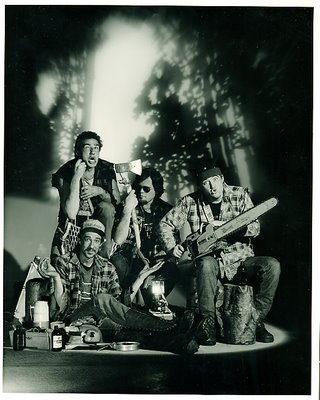
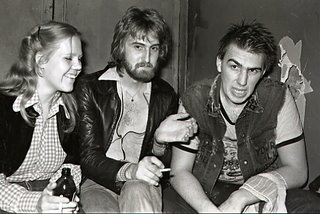
Sometime in 1979 0r 1980 I went to see the band Devo (Are We Not Men?) at the Commodore Ballroom. I was completely turned on by the sound of their guitars. The only reason I was there is that Les Wiseman (right between Joey and Joey's first wife Cheryl whom Mac Parry always addressed as Mrs. Shithead), who wrote a rock column (In One Ear) for Vancouver Magazine had told me we had to go. I knew nothing of rock and roll and much less anything related to punk or new wave music. Five years before when I lived in Mexico City I liked listening to the happy music of Ray Conniff. It was the Devo concert and a previous experience listening to Art Bergmann and the K-Tels at the Smiling Buddha that had awakened my enthusiasm for the raw-short-loud-primitive sound of punk. Leaving the Devo concert I will always remember seeing this scary, loud and angry man who somehow had not liked the Devo concert. That was my first glimpse of Joey Shithead (a.k.a. Joe Keithley In my long association with the lead singer of D.O.A. I learned to quickly realize that he was a gentleman (with an emphasis in gentle) but who will always be Vancouver's best spitter. Shortly after the Devo concert I took my first picture of Joey at the Buddha seen here with Simon on bass.
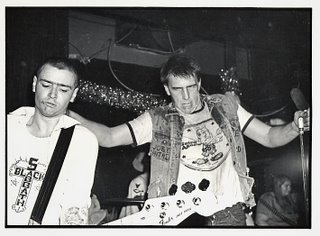
It was in 1984 that he knocked on my door in Burnaby, and said, "Alex we need a band photograph that is going to be published in Interview Magazine.. I remember that for this elaborate photograph, above left, I used many lights and I got paid very poorly but this was my first published photograph in a New York publication.
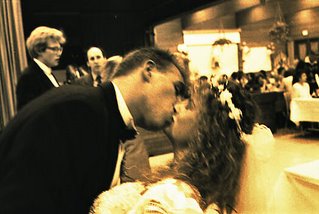
Through the years Joey has been so pursuasive that I even photographed his wedding. Note, Wimpy Roy, a.k.a. Brian Goble (Subhumans, D.O.A.) feeding his baby at the ceremony.
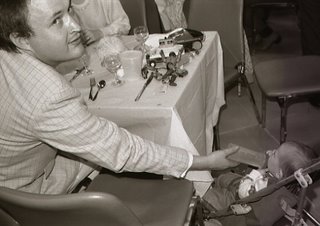
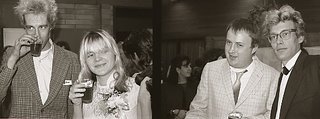
Below you will see a picture of D.O.A. at the Smiling Buddha shaking some beer.
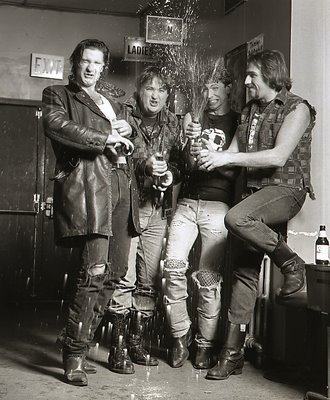
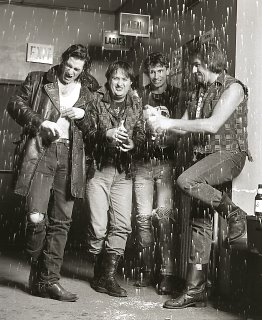
Note the picture at Gary Taylor's Rock Room with Joey on stage Taking Care of Business with Randy Bachman.
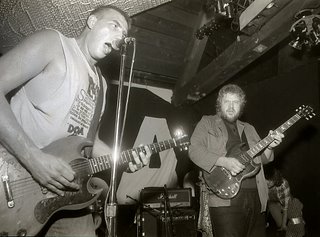
And the pictures all make me smile even the one I took in an 80s Yaletown.
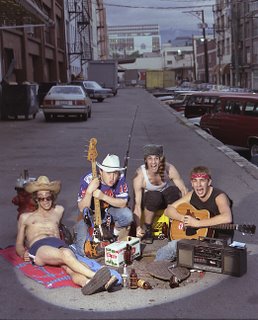
I borrowed a fire hydrant from the city and carrying it in my Fiat I managed to break the seat. My favourite ever configuration of D.O.A. is this one seen below. It featured from left to right, Wimpy, Dave Gregg, Joey and Dimwit. It was Dave Gregg's fantastic guitar in tandem with Joey's that made any D.O.A. concert an exciting sonic experience.
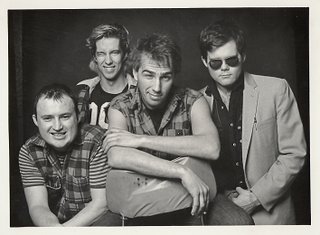
To be safe from all the pogoing and other near and on stage shennanigans I always positioned myself on stage right, right under that other gentle soul, Gregg who always made sure nobody ever bothered me and my photo gear.
D.O.A. Fans
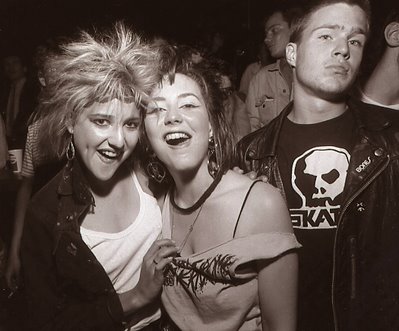
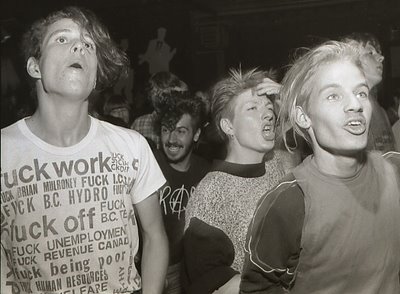
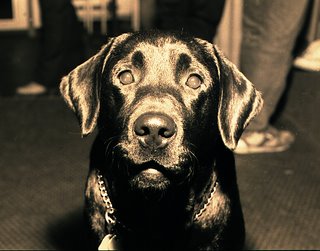
Perhaps one of D.O.A. biggest and most generous fan was pioneer music video maker Brian Ross who appears here with Joey. I remember having to go to Granada Television who gave me the TV cabinet for the picture. I also had to rent a smoke machine from the CBC for the shot. Ross made the video on a rock bottom budget.
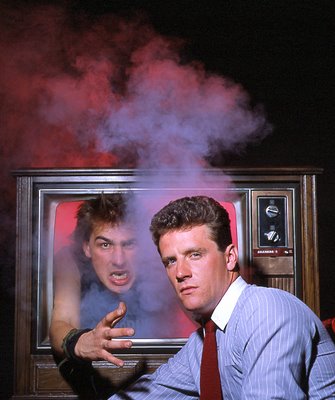
In Praise of Terry David Mulligan
Tuesday, January 30, 2007
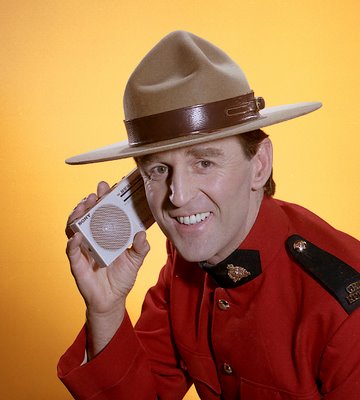

In my 32 years in Vancouver I have photographed many people and the list is getting longer and longer as I have yet to stop. But few people I have photographed through those years were as gracious and as pleasant as Terry David Mulligan. No, Mulligan is not dead. I remembered him this morning as I was driving Rosemary to work. On 1st and Columbia I stopped to let a black unmarked Vancouver Police cruiser pass by. The man at the wheel (he had no passenger) seemed to be very busy with a cell phone in his left ear.
At least 11 years ago (in one of the many times I photographed Terry David Mulligan) I was riding in Mulligan's van. We were going to pick up his dog at the dog groomers for a photograph for TV Guide. The phone rang in the van and Mulligan pressed a button. He had his cell phone connected to his van's sound system and he did not have to let go of any of his hands to talk.
It would seem to me that Mulligan's early years in the Royal Canadian Mounted Police served him well and he knew all about driving safely. If only our Vancouver's Finest would follow his example!
It is always good to find a reason for writing about Terry David Mulligan as I can show off some of the many photos I took of him. He has always been a ham and a good sport. Here he is with his personal trainer.
Malcolm Parry's Privileged Position
Monday, January 29, 2007
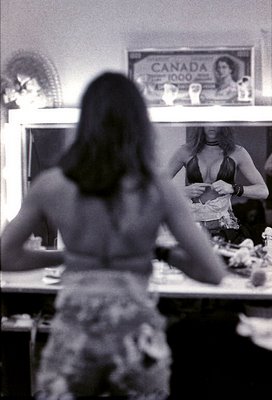
Malcolm Parry has a definition for the privileged position. A person in such a position is able to see what most cannot. This is why he dispatched many photographers to take pictures from the top of bridges, very high buildings or to fly low in a helicopter over Wreck Beach. In one such instance that I would rather forget he made my fly in a Harvard trainer (the British version of the AT-6 Texan) to photograph a stunt team flying upside down through the Lions in West Vancouver. To do the job I had to fill my mouth with Dramamine.
I do agree with Mac that looking up from below is not privileged. One has to be above and looking down. But I also believe that there are other forms of privileged positions. I remember vividly being told by a customs officer in the Acapulco airport that I could not bring in all my photographic equipment. I respectfully asked him to turn around as there was a gentleman there who had the necessary permits. He turned around and there was my friend Licenciado Felipe Ferrer Junco, the chief of the city's Judicial Police and his bodyguard holding an AK-47. I was whisked away without my bags being searched. I felt most privileged.
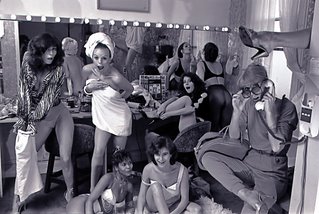
And here are two more examples of a privileged position of sorts. They were taken in the dressing rooms of well known Vancouver strip parlours. The one above left was at the Number 5 Orange and the other at the Drake Hotel.
Jack Diamond, The Brush Man & The Sure Bet
Sunday, January 28, 2007
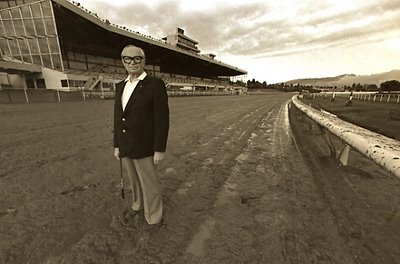
In 1972 I had a teacher friend in Mexico City who had fled Cuba with his family during Castro's takeover. His name was Jorge Urréchaga. He taught English literature and was a fine operatic tenor. He had a system for betting horses. Every once in a while he would call me in the morning to tell me that he, Rosemary (my wife) and I were going to dine in the evening. I always knew what that meant. In the afternoon I had to accompany him to the horse races at the Hipódromo De Las Américas. His system involved meeting up with a Jewish man when they paraded the horses before the race. The man had a brush company. Most of his brushes used horse hair and he was an expert in determining when a horse was healthy or not. We would watch the races and we would never bet until Jorge would say, "¡Ahora, sí!" I never really liked to bet even when the bet seemed to be a sure one so my winnings were much more modest than Jorge's. We always won and we invariably celebrated in the evening with Champagne at Sep's our favourite restaurant, which served food from Alsace-Lorraine. It was on Tamaulipas street about a block from the house where Edward Weston had lived and photographed Tina Modotti nude on the roof. I am not sure if the brush man was part of the appearance and Jorge just knew which races were fixed. I never asked him. He never seemed to abuse his knowledge. He played excellent bridge and had the ability of being able to memorize instantly any deck of cards from minute imperfections on the edges or nicks on their backs. I never lost at bridge when he was my partner.
I supect my father was a burrero, which is the Argentine slang for someone who bets on the horses. He took me to the imposing hipódromo in Buenos Aires a few times and I was always impressed and intimidated by his friends who all seemed to carry a gun in the armpit.
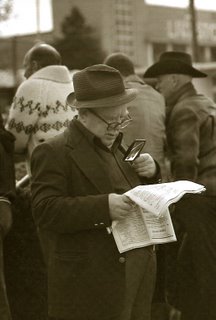
It is perhaps for this reason that I have never enjoyed horse racing and boxing, another sport that seems to be seedy and subject to rules that exceed the mathematical ones on chance.
In October 1987 Harvey Southam dispatched me to photograph Jack Diamond at Exibition Park for his magazine, Equity. It had rained all week so when I indicated to Mr. Diamond that I wanted to photograph him on the race course he told me we were going to get dirty. We did.
I will never forget what followed my photograph. He told me, "Alex, let's go inside and get our shoes shined. I remember very well how he slipped the shoe shine man a bright red $50 bill.
Saturday, January 27, 2007
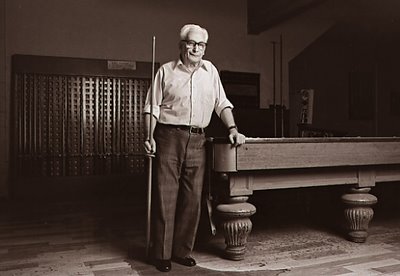
I remember exactly what I was doing on the afternoon of September 26, 1960. I was shooting pool in the Junior/Senior rec room at St. Ed's High School in Austin, Texas. The four or five of us in the room were part of the 70 million who were watching Senator John F. Kennedy debate Vice President Richard Nixon. Since our school was a Catholic boarding school we were all proud of the senator and thought Nixon looked terrible. This he did as he waved away efforts to put Max Factor's pancake on his face. The UV light generated by the hot lights of the TV studio made his skin look sickly in pallor.
In my senior year (spring 1961) at the school I was caught reading under a tree and the photo appeared in the annual.
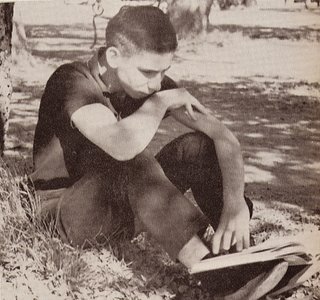
The funny thing is that I remember the date as it was one day after the week of the Bay of Pigs fiasco. It was a very hot Texas spring day, April 20. We had Cuban boys boarding in the school and when we saw Walter Cronkite on TV and found out all was lost we felt ashamed and did not know how to explain to them how our hero had failed.
Sometime in 1977 I took this photograph of the man who ran a pool hall on Fraser Street. He had been at it for over 50 years and was known by all who shot pool. I do not remember his name but I keep his portrait as a link to my youth and that pool hall so long ago in Austin, Texas.
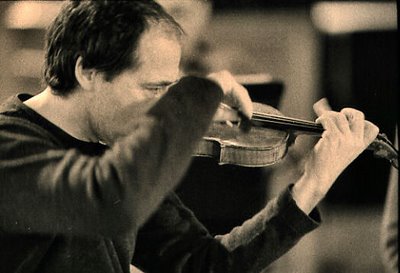
I have heard several live performances of Francesco Geminiani's La Folia but the best I will ever hear I heard yesterday.
Richard Berry wrote the rock’n’roll song Louie Louie in 1955. It is a standard in rock and pop since hundreds of versions have been recorded by many artists. My fave is one recorded live by Johnny Thunders. The song is written in the style of a Jamaican ballad; and it is the first-person story of a Jamaican sailor returning to the island to see his girl. He brags of his “fine girl” to the Louie of the title who is, perhaps a bartender.
Ignorance is terrible, but fortunately one has until death’s door to try to make up for it. I had never heard of La Folia. I had heard of Italian composer Arcangelo Corelli (1653-1713) in the late 50s during the Archiv record renaissance that made baroque music known. It was some 7 or 8 years ago that Ballet BC performed a beautiful number to recorded music of Francesco Geminiani’s (1687 -1762) Concerto Grosso No. 12 in D minor, ‘La Folia’ which was an arrangement of his former teacher's (Corelli), Variations in D minor, ‘La Follia’ (Op. 5, No. 12). I would not know why Corelli's Follia is written with two ls while Geminiani's is written with only one. But there is one reason (for me) why Geminiani's Folia is more fun than his teacher's. Geminiani did not ignore the virtuoso possibilities of the viola and in his variations it shares the bill with the violin and the cello.
It was my friend and baroque music enthusiast Graham Walker who clued me in to Corelli's La Follia and his pupil's even more popular variations. Graham suggested I purchase Trio Sonerie (Monica Huggett, Mitzie Meyerson, Sarah Cunningham) with Nigel North Corelli Volin Sonatas Op. 5 (which includes La Follia. It is easily one of my favourite CDs. Since then I have heard many versions named as folias and some that are not (but instantly recognizable as such) like Faronell's Division on a Ground in David Douglas, Paul O'Dette and Andrew Lawrence-Kings, Apollo's Banquet CD. And once I discovered the web site on all things Folia, I further found out that at least 150 composers have written variations over the last 330 years.
According to my Real Academia dictionary folía is a word of French origin that means mad. It is further defined as a dance typical of the Canary Islands but also an extrmely noisy Porutuguese dance that involved many people. This is partially confirmed by the Folia website and I quote:
The name "Folia" is of Iberian origin and refers to a fertility dance in three-four time originating in the late 15th century. The first time the name emerges is in a text by the Portuguese dramatist Gil Vicente entitled "Auto de Sibilla Cassandra". In music Folia meant, at least till the 1670's, a very quickpaced and tumultuous dance, in which the dancers carried men dressed as women upon their shoulders. They were literally driven mad by the noise and the stirring rhythm.
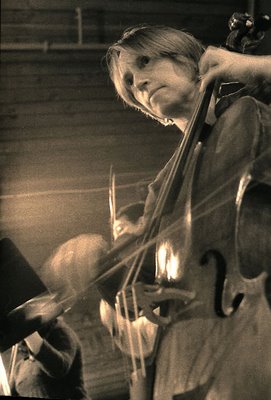
This week I had to take rehearsal photographs of the Pacific Baroque Orchestra, which included Geminiani's La Folia. Once I had finished I had a spur of the moment idea. I got as close to Laura Kramer's cello (right) taking advantage that a baroque cello has no spike so I could safely lay down on my back. While the orchestra laughed (privately they must have thought the earlier morning rehearsal of La Folia had perhaps deranged me slightly!) the PBO's musical director and virtuoso violinist, Marc Destrubé (above, left) gave me the nod to remain. I was almost under Valerie Weeks's harpsichord. For too long I have ignored it's all too subtle sound. From where I was, for the first time, I really appreciated it. It seemed to be in my head while my left ear caught the vibrations of Nan Mackie's violon and my right, Kramer's cello.
When Geminiani's La Folia ended I heard sounds coming out of Kramer's cello almost as if the instrument, all on its own, was producing further variations on the variations. What delicious madness!
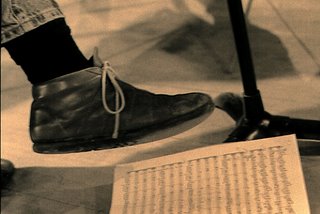
For those who might be in Victoria over the weekend here is your chance to listen to the PBO play Geminiani's La Folia (and many other worthy composers), and soprano Nancy Argenta, January 26, 27 and 28. Folia and Nancy Argenta
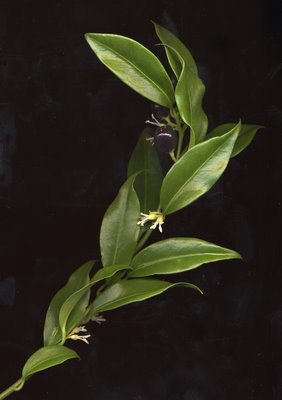
Arriving home a couple of days ago as I was about to open my front door when I was almost overcome by an extremely sweet and powerful fragrance. Yes, days are finally getting longer and spring is around the corner. It takes the only bush in my garden that blooms right now to remind me of this. That's Sarcococca ruscifolia the plain Jane of the garden in some gardens, but not in mine.
By mid January I have almost forgotten the short and dark days of November. The Christmas lights of December helped a bit. The fallen picket fence and the many leaning or damaged trees in my garden, including a large and shaped juniper that that had to be cut down, remind me that my garden is as human as I am and age takes its toll. Yet that powerful fragrance at my front door, the perfume of Sarcococca ruscifolia jars me into realizing that there will be some renewal of tissue in the spring and that all is not decay and death. But there is some death (so Rosemarys says) in the tiny flowers (smaller than my pinky's nail) of the Sweet Boxwood (also Sweet Box Wood or Vanilla Bush). In Spanish we say, "El que pega primero, pega dos veces," or he who hits first, hits twice. In the mid January garden most plants are dormant but Sarcococca ruscifolia is in full bloom and will remain so until the end of February. It simply has no competition from any other flowers in the garden. Not only is this a noble plant because of its flower's punch but the red berries of summer become are shiny and black and persist even now. I cut two branches for last night's scan and then left them in the kitchen. Rosemary said, "Alex it smells like a funeral parlour." I told her that the plant also had the name of Vanilla Plant. She agreed. I left the kitchen and came back and the fragrance now reminded me of honey.
Until I find someone who can explain how Sarcococca blooms do it, I will have to only marvel at the plant's uncommonly volatile perfume. Volatility is usually porportional to temperature. The warmer the day the more a fragrance will spread. Or at least this is what I thought. I wonder how in very low temperatures such a tiny flower's fragrance can spread. Could it be that this Asian plant is a garden's kind equivalent to the spreading capabilities of polonium 210?
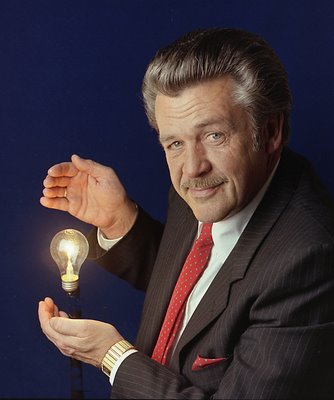
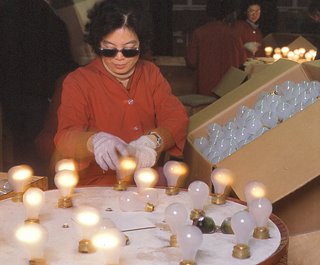
In May 1985 Equity Magazine editor Harvey Southam looked at me and smiled. He then said, "Alex get your gear we are going to visit Turton in Burnaby. I quickly found out the reason for his smile as soon as we entered the cavernous wearhouse building. It was a world I had never seen or supected that it would exist in our very own Burnaby. It was light bulb factory. Ted Turton was a Vancouver businessman who often appeared in the pages of the Vancouver Sun during the years that the Vancouver Stock Exchange was in existence. How could it be that a man used to making money by transfering numbers on papers from here to there, was suddenly manufacturing hard goods? Perhaps I was too stupid or I was simply not curious to ask Southam, nor alas, did I ever read the article my photographs, seen here, illustrated. I could cite the circumstances that were the direct result of the photograph with Turton and his two principals in my photograph.
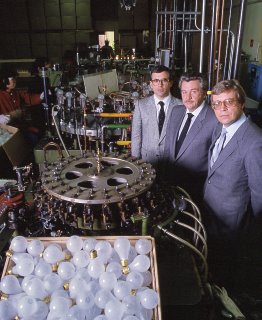
The Mamiya RB-67 Pro-S was on a very high Hi-Boy tripod which had always been notorious for its instability. I came crashing down and my camera and its parts went in every direction on the very hard concrete floor. I was able to put it together again to take this picture. Having to get expensive "body work" on my camera the next day is my only excuse for not asking more info from Southam on Turton. Whenever I mentioned the name, he would only smile with that infectuous smile I remember he had.
Since this was the pre Photoshop era, my light bulb trick used before here consisted in soldering a wire to the bulb and then dipping it into Varathane varnish so my subject could hold it without getting electrocuted. But to give the effect of levitating the bulb I had soldered a blackcoat hanger wire on the bottom part of the bulb. I had previously used this trick to have BC Lions's players levitate footballs.
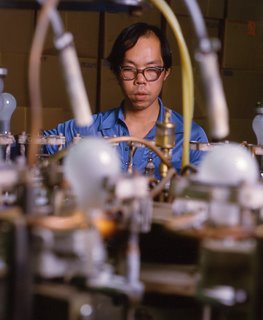
I look back at this picture with the nostalgia of thinking that perhaps businessmen were more interesting and quirky then. I also despair in the knowledge that in Vancouver we manufacture next to nothing, any kind of stuff that occupies physical space.

I remember exactly what I was doing on the afternoon of September 26, 1960. I was shooting pool in the Junior/Senior rec room at St. Ed's High School in Austin, Texas. The four or five of us in the room were part of the 70 million who were watching Senator John F. Kennedy debate Vice President Richard Nixon. Since our school was a Catholic boarding school we were all proud of the senator and thought Nixon looked terrible. This he did as he waved away efforts to put Max Factor's pancake on his face. The UV light generated by the hot lights of the TV studio made his skin look sickly in pallor.
In my senior year (spring 1961) at the school I was caught reading under a tree and the photo appeared in the annual.

The funny thing is that I remember the date as it was one day after the week of the Bay of Pigs fiasco. It was a very hot Texas spring day, April 20. We had Cuban boys boarding in the school and when we saw Walter Cronkite on TV and found out all was lost we felt ashamed and did not know how to explain to them how our hero had failed.
Sometime in 1977 I took this photograph of the man who ran a pool hall on Fraser Street. He had been at it for over 50 years and was known by all who shot pool. I do not remember his name but I keep his portrait as a link to my youth and that pool hall so long ago in Austin, Texas.
La Folia - A 16th Century Louie Louie
Friday, January 26, 2007

I have heard several live performances of Francesco Geminiani's La Folia but the best I will ever hear I heard yesterday.
Richard Berry wrote the rock’n’roll song Louie Louie in 1955. It is a standard in rock and pop since hundreds of versions have been recorded by many artists. My fave is one recorded live by Johnny Thunders. The song is written in the style of a Jamaican ballad; and it is the first-person story of a Jamaican sailor returning to the island to see his girl. He brags of his “fine girl” to the Louie of the title who is, perhaps a bartender.
Ignorance is terrible, but fortunately one has until death’s door to try to make up for it. I had never heard of La Folia. I had heard of Italian composer Arcangelo Corelli (1653-1713) in the late 50s during the Archiv record renaissance that made baroque music known. It was some 7 or 8 years ago that Ballet BC performed a beautiful number to recorded music of Francesco Geminiani’s (1687 -1762) Concerto Grosso No. 12 in D minor, ‘La Folia’ which was an arrangement of his former teacher's (Corelli), Variations in D minor, ‘La Follia’ (Op. 5, No. 12). I would not know why Corelli's Follia is written with two ls while Geminiani's is written with only one. But there is one reason (for me) why Geminiani's Folia is more fun than his teacher's. Geminiani did not ignore the virtuoso possibilities of the viola and in his variations it shares the bill with the violin and the cello.
It was my friend and baroque music enthusiast Graham Walker who clued me in to Corelli's La Follia and his pupil's even more popular variations. Graham suggested I purchase Trio Sonerie (Monica Huggett, Mitzie Meyerson, Sarah Cunningham) with Nigel North Corelli Volin Sonatas Op. 5 (which includes La Follia. It is easily one of my favourite CDs. Since then I have heard many versions named as folias and some that are not (but instantly recognizable as such) like Faronell's Division on a Ground in David Douglas, Paul O'Dette and Andrew Lawrence-Kings, Apollo's Banquet CD. And once I discovered the web site on all things Folia, I further found out that at least 150 composers have written variations over the last 330 years.
According to my Real Academia dictionary folía is a word of French origin that means mad. It is further defined as a dance typical of the Canary Islands but also an extrmely noisy Porutuguese dance that involved many people. This is partially confirmed by the Folia website and I quote:
The name "Folia" is of Iberian origin and refers to a fertility dance in three-four time originating in the late 15th century. The first time the name emerges is in a text by the Portuguese dramatist Gil Vicente entitled "Auto de Sibilla Cassandra". In music Folia meant, at least till the 1670's, a very quickpaced and tumultuous dance, in which the dancers carried men dressed as women upon their shoulders. They were literally driven mad by the noise and the stirring rhythm.

This week I had to take rehearsal photographs of the Pacific Baroque Orchestra, which included Geminiani's La Folia. Once I had finished I had a spur of the moment idea. I got as close to Laura Kramer's cello (right) taking advantage that a baroque cello has no spike so I could safely lay down on my back. While the orchestra laughed (privately they must have thought the earlier morning rehearsal of La Folia had perhaps deranged me slightly!) the PBO's musical director and virtuoso violinist, Marc Destrubé (above, left) gave me the nod to remain. I was almost under Valerie Weeks's harpsichord. For too long I have ignored it's all too subtle sound. From where I was, for the first time, I really appreciated it. It seemed to be in my head while my left ear caught the vibrations of Nan Mackie's violon and my right, Kramer's cello.
When Geminiani's La Folia ended I heard sounds coming out of Kramer's cello almost as if the instrument, all on its own, was producing further variations on the variations. What delicious madness!

For those who might be in Victoria over the weekend here is your chance to listen to the PBO play Geminiani's La Folia (and many other worthy composers), and soprano Nancy Argenta, January 26, 27 and 28. Folia and Nancy Argenta
Sarcococca ruscifolia - Polonium 210 In The Garden
Thursday, January 25, 2007

Arriving home a couple of days ago as I was about to open my front door when I was almost overcome by an extremely sweet and powerful fragrance. Yes, days are finally getting longer and spring is around the corner. It takes the only bush in my garden that blooms right now to remind me of this. That's Sarcococca ruscifolia the plain Jane of the garden in some gardens, but not in mine.
By mid January I have almost forgotten the short and dark days of November. The Christmas lights of December helped a bit. The fallen picket fence and the many leaning or damaged trees in my garden, including a large and shaped juniper that that had to be cut down, remind me that my garden is as human as I am and age takes its toll. Yet that powerful fragrance at my front door, the perfume of Sarcococca ruscifolia jars me into realizing that there will be some renewal of tissue in the spring and that all is not decay and death. But there is some death (so Rosemarys says) in the tiny flowers (smaller than my pinky's nail) of the Sweet Boxwood (also Sweet Box Wood or Vanilla Bush). In Spanish we say, "El que pega primero, pega dos veces," or he who hits first, hits twice. In the mid January garden most plants are dormant but Sarcococca ruscifolia is in full bloom and will remain so until the end of February. It simply has no competition from any other flowers in the garden. Not only is this a noble plant because of its flower's punch but the red berries of summer become are shiny and black and persist even now. I cut two branches for last night's scan and then left them in the kitchen. Rosemary said, "Alex it smells like a funeral parlour." I told her that the plant also had the name of Vanilla Plant. She agreed. I left the kitchen and came back and the fragrance now reminded me of honey.
Until I find someone who can explain how Sarcococca blooms do it, I will have to only marvel at the plant's uncommonly volatile perfume. Volatility is usually porportional to temperature. The warmer the day the more a fragrance will spread. Or at least this is what I thought. I wonder how in very low temperatures such a tiny flower's fragrance can spread. Could it be that this Asian plant is a garden's kind equivalent to the spreading capabilities of polonium 210?
Ted Turton Has An Idea - In Burnaby
Wednesday, January 24, 2007


In May 1985 Equity Magazine editor Harvey Southam looked at me and smiled. He then said, "Alex get your gear we are going to visit Turton in Burnaby. I quickly found out the reason for his smile as soon as we entered the cavernous wearhouse building. It was a world I had never seen or supected that it would exist in our very own Burnaby. It was light bulb factory. Ted Turton was a Vancouver businessman who often appeared in the pages of the Vancouver Sun during the years that the Vancouver Stock Exchange was in existence. How could it be that a man used to making money by transfering numbers on papers from here to there, was suddenly manufacturing hard goods? Perhaps I was too stupid or I was simply not curious to ask Southam, nor alas, did I ever read the article my photographs, seen here, illustrated. I could cite the circumstances that were the direct result of the photograph with Turton and his two principals in my photograph.

The Mamiya RB-67 Pro-S was on a very high Hi-Boy tripod which had always been notorious for its instability. I came crashing down and my camera and its parts went in every direction on the very hard concrete floor. I was able to put it together again to take this picture. Having to get expensive "body work" on my camera the next day is my only excuse for not asking more info from Southam on Turton. Whenever I mentioned the name, he would only smile with that infectuous smile I remember he had.
Since this was the pre Photoshop era, my light bulb trick used before here consisted in soldering a wire to the bulb and then dipping it into Varathane varnish so my subject could hold it without getting electrocuted. But to give the effect of levitating the bulb I had soldered a blackcoat hanger wire on the bottom part of the bulb. I had previously used this trick to have BC Lions's players levitate footballs.

I look back at this picture with the nostalgia of thinking that perhaps businessmen were more interesting and quirky then. I also despair in the knowledge that in Vancouver we manufacture next to nothing, any kind of stuff that occupies physical space.
Tuesday, January 23, 2007
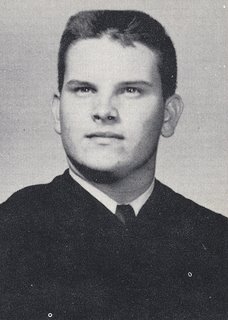
The last time I saw Howard Houston was in 1961. Both of us were wearing mortar boards as we were graduating from St Edward’s High School in Austin, Texas. I really had not known him very well for the first four years that I was a boarder at the Catholic school. Howard was day student. I was keenly jealous of his literary wit and his ability to write essays with almost no effort. I was jealous on how he could make the class laugh with his intelligent, intellectual and sophisticated humour. Meanwhile I had to fight back my own shyness and having no girlfriends because I did not know how to dance. I was a real geek. Knowing how to dance in sock hops was the only way we could meet girls. We could only go to town for a limited time on weekends. The girls from the Catholic school across the city, St Mary’s Academy, were bussed to our sock hops. They needed chaperoning as the only women we saw on campus was the one female cook who served us Korean War issue powdered eggs for breakfast.
Brother Edwin -St Ed's
Brother Edwin and the Easter Bunny
St. Ed's & Friendship
Brother Stanley and the circular slide rule
St Edward's High School Alumni Association Web Site
After our graduation Howard visited me at my home in Mexico City and we got to know each other better. He had been interested in my Pentacon single lens reflex back at St Ed's so he brought a much improved Miranda reflex camera. I was jealous! He took these pictures in Mexico from my apartment window facing Avenida Insurgentes Sur. Howard was fascinated with the mishmash of cars in Mexico City.
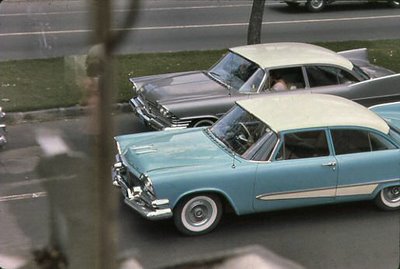
In particular he was delighted/horrified by the Plymouth Kingsway. This was a cheaped down Dodge that had a Dodge front end but the curvy fins of a Plymouth.
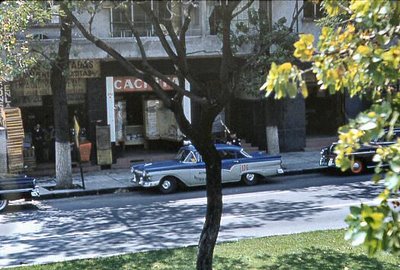
A few years back I found Howard through a web based St Edward’s reunion page. We have been happily communicating since. Howard lives in a very small community not too near Austin and his house is by a lake. I am happy to report that Howard’s wit has not changed in the least and that I am still jealous. For over a year he kept telling me how he had worked for the US Government. Only after some pressing on my side did he reveal that his government job was piloting a Boeing KC-135 tanker and that he and his crew re-fueled Phantom jets over Vietnam. I recently wrote to Howard for an explanation as to why he likes to live in isolation. Here is his delightful reply:
--------------------------------------------------------------------------------------------------------------------------------
In the movie Those Magnificent Men in Their Flying Machines, the opening scene happens at the start of a great international air race at an air park in England. The scene opens with Lord Whatsisname riding onto the field in his Rolls Royce with his male secretary. Lord Whatsisname says something like "You know Cyril; these international events would be quite all right if it were not for all the foreigners."
While I tend to agree with His Lordship on that, my real feeling is that "You know Alex, these public events like the opera, concerts, etc., would be quite all right if it were not for all the people."
I like people as individuals and in small groups. I literally cannot stand crowds. With an individual or a small group, you can sidle away from poor personal hygiene, ill mannered children, deadly boors, and people who want to convert you to their beliefs on whatever subject you care to name. However, in a crowd such people are, like pustules on the skin of a victim of smallpox, spread evenly throughout the mass thereby making it almost impossible to escape them. I, too, like the activities you mention, but would much prefer them after the local Legion Commander had ordered decimation; or several decimations. I think I was born to be an absolute monarch with private plays and concerts for a few select friends.
Other people like to press the flesh, so to speak, and big cities. I have no problem with that and, in fact, encourage it as those who like crowds will only find the crowds in the big cities and they have to go there to join the crowds thereby keeping the crowds where they belong, in the big city rather than out here with me.
We had 36 hours of continuous light sleet and freezing rain last week. It was the usual comedy of Texans trying to drive on ice as if it were no different than asphalt. The City of Austin was literally closed down for two full days. No mail delivery even.
Guest blogging! You have moved on into a fairly rarified atmosphere now. The internet and contraception for women. Vast and unpredictable changes are in the wind. Hillary is running for president. If she wins, those boys in the Middle East had better look out. Females protecting their children are considerably more dangerous than the male of the species. Also, she won't be too impressed with the colors available in hijabs.
Howard
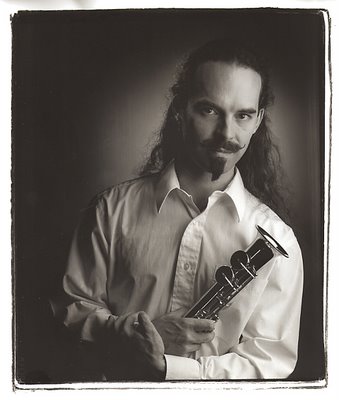
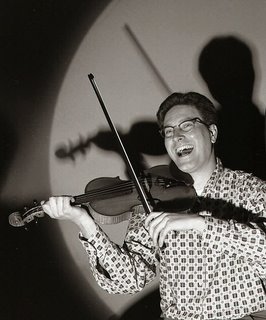
When London Calling came out in 1980 I remember driving back from Vancouver, Washington with my friend Les Wiseman. We passed through Seattle in the evening through the extra speedy inside freeway. As we sped in my Fiat X-19 the lights of the city flashed by in a blur as we listened to The Clash. I discovered then a new exciting genre of music that I call music-to-listen-to-while-driving- fast-through-a-city-at-night-or-on-a-long-bridge ( in a laid back Italian position, arms straight holding the steering wheel, with the seat as far back as possible).
For the music to be part of this genre it has to have an inexorable sense of purpose, an unfliching beat and, of course, it has to be heard extremely loud. I think Johann Sebastian Bach's Brandenburg Concerto No 2, in the super fast Pablo Casals version, would qualify as would (pure conjecture of mine) Joseph Haydn's Symphony No. 22, The Philosopher if it were performed on music overdrive. I cannot think of any 19th century music that fits the bill but in the 20th century, Maurice Ravel's Bolero would do me fine as would any composition by Philip Glass. In jazz, Paul Desmond's Take Five performed by the Dave Brubeck Quartet would shorten any trip. Perhaps its odd and disquieting (and obsessive) 5/4 time signature helps.
I thought of all the above as I had one heck of great time last night listening to composer/musician Colin MacDonald (above, left) and his Pocket Orchestra playing his music and that of three other contemporary composers. At least two, including Michael Nyman's Prospero's Magic had a bit of that Glass obsession and I was frustratingly trying not to "air" drive an exotic Italian car through Seattle at night. There were several reasons why the experience was pleasant. Besides Colin MacDonald on soprano saxophone, my friends, violinist Paul Luchkow (above, right) and cellist Laura Kramer (below, left) were part of the pocket orchestra.
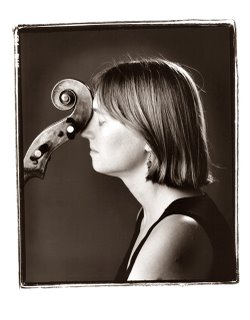
I was accompanied by Graham Walker, my eldest daughter Ale (who brought snacks) and Paul's wife, violist Glenys Webster. Our new friend, visiting German Philipp Krieg, also raved about our evening.
MacDonald's Skillful Means was excellent bridge-crossing-material made all the better by an enthusiastic alto saxophonist, David Branter who, after my playing friends, was easily my favourite in the orchestra. Sitting next to MacDonald's soprano sax and with bass trombonist Brad Muirhead ( it looked like a normal trombone as the bell seemed small but it all had to do with the fact that Muirhead was one big man) behind, this was a solid brass and woodwind section that had a cool trumpet player in Geeta Das, who played in the later compositions. Her serious face contrasted sharply with Branter and the smiling Daniel Tones on percussion.
MacDonald's Reaching for Immortality , while having players performing in what this amateur reviewer would state was out of phase (Paul Luchkow told me it was fun to not have to play normal ensemble playing) had a very pleasant romantic streak.
But it was the last composition of the evening, Macdonald's The 5-Chambered Heart that was the high point of the evening for me. It had a 5/4 beat that was much too complex for me to figure out. It was a miracle that the orchestra could keep up with each other after I was told how little time they had to rehearse. The piece ended nice and slowly as my Maserati and I reached our destination.
It would not be fair for me not to mention that this Pocket Orchestra had Ya-Wen Vivienne Wang on the piano, Cori Somers on violin, Jared Burrows on bass guitar and Stefan Hintersteiniger on cello. The latter could take some smiling lessons from Laura Kramer who does it so well, besides playing a damn good cello.
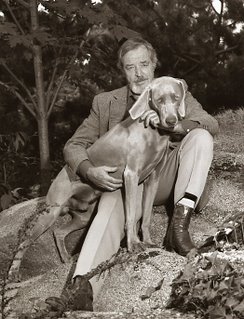
For me the only bittersweet part of the evening was sensing the ghost of my departed lefty friend Ben Metcalf who will always haunt the small and intimate Western Front where this entertaining concert was held.
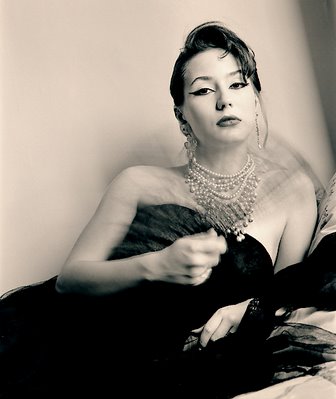

In the late 70s and early 80s Holly Suicide, who looked like an overly made-up street urchin haunted the punk concerts of the Smiling Buddha on Hastings Street. She sometimes taunted the huge egg-shaped Igor the bouncer. As scary as I had first thought it all was, one could safely walk the streets then. My friend Les and I would walk to the Balmoral Hotel for its "cleaner" bathrooms and cheaper beer. I don't know what it was that Les might have said or done but he was actually ejected from the Balmoral one night.
When I drive North on West Georgia I sometimes look up to the old building on the north-east side, right on the corner with Bute.
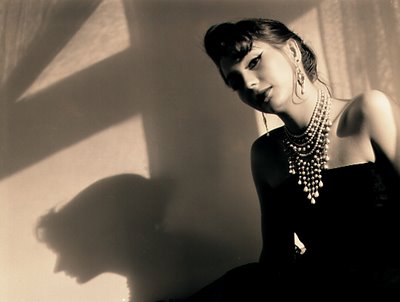
It is astounding that this relatively attractive old building with trapezoidal bay windows has not come tumbling down to make way for The Newton west coast adult living condominium.
It was there that in the late 80s I photographed Holly Suicide's alter ego, Daniela Ciccone. I had that uncommon pleasure of looking out from the inside of those lovely bay windows.
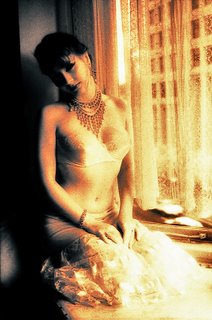
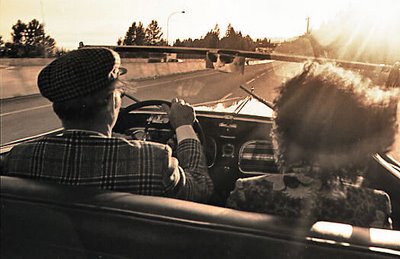
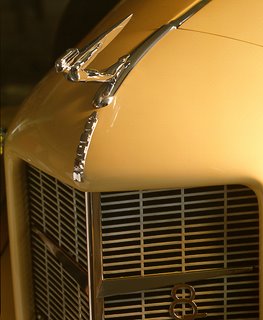
On any nice sunny day in the garden, especially on Sundays when the noise level of nearby Granville Street is down I have been listening to a strange whistling sound that has grown on me. The Kerrisdale tracks are seldom used by trains these days. I miss that midnight train siren. The only sound that evokes the romance of transport from the past is that curious relatively new whistle. My friend Paul Leisz who has been know to drive one, says it's the supercharger of the B-Line articulated bus engine.
In the mid 80s my daughter Ale and I had a thrilling ride in Ed Aveling's convertible Auburn. As we sped on the Upper Levels Highway I heard the whistling sound. I asked Aveling what the noise was. "It's the supercharger."
I photographed Aveling's Auburn and other antique cars for an article that Alyn Edwards had written for Vancouver Magazine. I got to see many fine cars but Aveling's Auburn was tops.
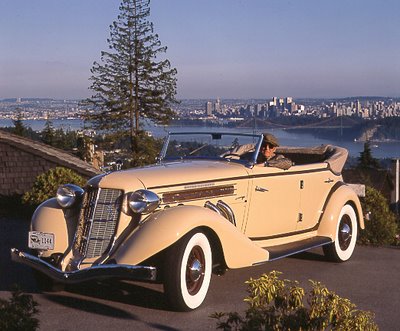
He lived in a house in West Van. In his living room he invited us to go down to the motor rooms to see his collection. It was then that I realized that he had designed (Aveling was a contractor) his house around separate garages (the motor rooms). He told me he had recently spent $7000 on new leather upholstery for the Auburn.
When Ale saw the car she asked, "Why is it that new cars in a showroom don't look as new as this one?"
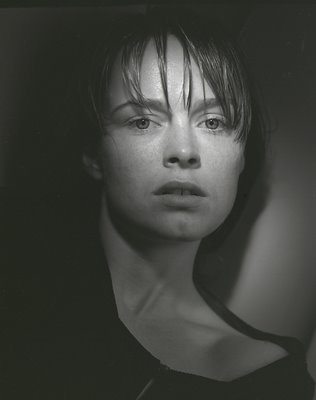
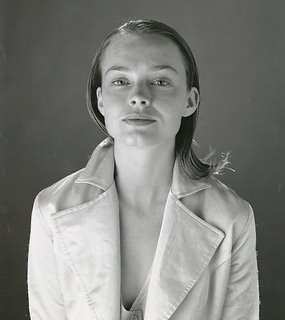
I first met Corrie Clark ten years ago at an acting agency Christmas party. Malcolm Parry had invited me to accompany him on an evening's activities. Mac bantered with this diminutive young lady whose face could change so quickly that she reminded me of Jean Seberg, Rebecca de Mornay, a young Alice Liddell and in some moments Audrey Hepburn. I decided to be direct. Corrie Clark was receptive and I had three photo sessions with her in my studio.
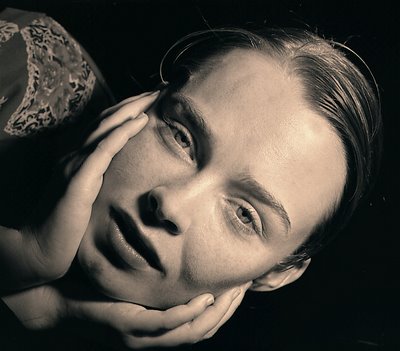
I don't think that in all my years as a photographer in Vancouver have I ever had such a clash of wills with anybody as I did with Clark. She was difficult, rude, unreceptive (at times) but when I looked at my contacts of her I realized how amazing our "collaboration" was. So I suffered in silence.
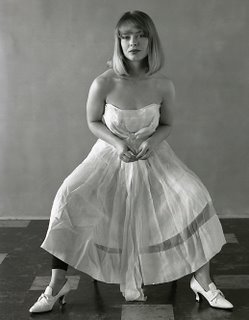
I asked her if she could cry on demand for my camera. She did this easily. There was a touch of bitterness in the 26 or 27 year-old actress. It seems that she had been typecast as teenager in all the movies she made. She longed to be "made up in full" - to play a real adult.
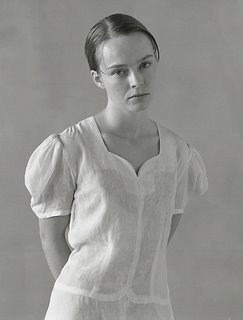
But that was not to be at the time. She also played the young girl who is raped. She told me how she would be placed on a revolving bed after having to remove all her clothes in a crowded set and told to fake an orgasm when the film rolled. She made the poignant observation that dogs and other animals were treated better in some local productions.
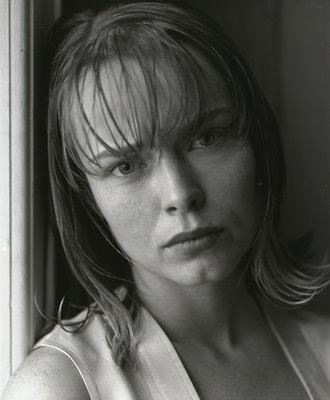
I put these photos away and I forgot them. Recently I received a an email from Clark where she apologized for her actions in the past.
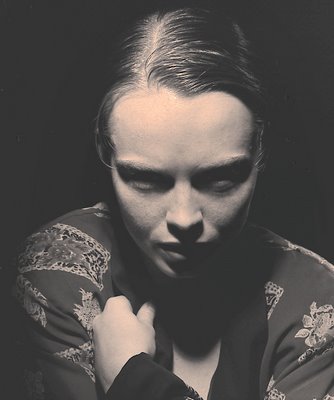
My only reaction is that I don't need an apology as these photographs are ample proof that I was rewarded in full.
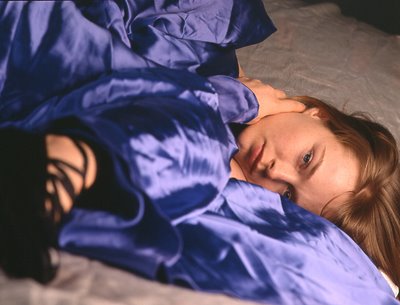
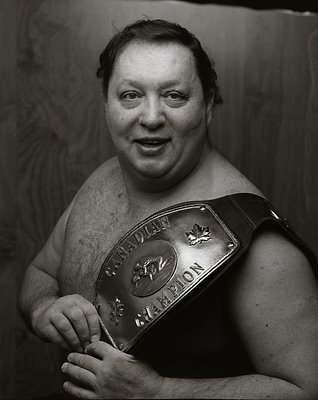
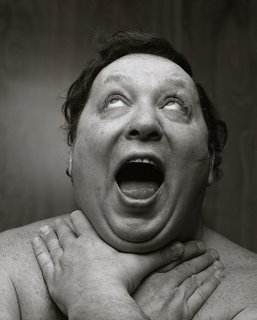
The past can seem rosy in some cases precisely because it was. I have never held a job in Vancouver but the closest I ever got to a 9 to 5 job was in the height of the 80s when I was virtually taking most of the pictures at Vancouver Magazine. Mac Parry's magazine was on the corner of Davie and Richards and looking back I can assert that it was a centre of all things cultural, musical, theatrical and sometimes, even, it was a circus.
Vancouver Magazine then was a city magazine, our city magazine, during an era when city magazines mattered. Everybody knew this so those who were part of the city went over to Vancouver Magazine and asked to see the editor. More often than not they got their wishes. I remember a young man who walked in from the street with a collection of slides of people wearing Hawaii T shirts. A month later the magazine had a feature with just those pictures. On any given day (on one given day of a Christmas party Mac invited the local prostitutes in for drinks with us) you could bump into Max Wyman or in this case with legendary Winnipeg wrestler Al Tomko. Mac came up to me and told me, "Go home and fetch your lights. I want you to photograph this gentleman." A gentleman he was and my past on Davie and Richards was truly rosy.
Al Tomko
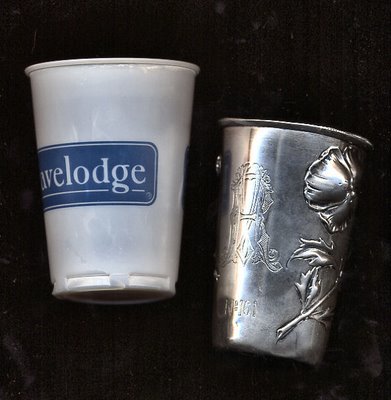
My maternal grandmother Lolita went to a boarding school for girls in Spain in the 19th century and was issued sterling silver cup No 161 to drink with her meals. I never asked her the name of the school or where in Spain her school was. I never asked her if all she drank out of it was water or how she polished it. By the mid 1950s the cup had been relegated to function as a toothpaste glass. We never ever called it a toothbrush glass. When I married Rosemary, she saw the sentimental value of cup 161 and insisted we display it with our collection of pocket watches and other family memorabilia.
For 39 years we have had a varied assortment of toothpaste glasses. In our early years in Burnaby, our daughters borrowed them for mixing watercolours and Rosemary and I might have popped Eno or Alka Seltzer to fight stomach ailments. I hated the plastic glasses and the glass ones either looked perpetually dirty or they would fall and break. I was much too lazy to vacuum the glass splinters. Once I bled over our white sheets with a cut foot. I learned my lesson. In the last year we have been practical. In a recent trip to Mexico we stayed overnight in a Seattle Travelodge and Rosemay pinched half a dozen plastic water cups which have been splendid. Or so I thought.
Rosemary's 15 year-old male cat, Toby, has always insisted in drinking his water from either the bathtub tap or the bathroom sink tap. Rosemary first tried leaving either taps running for a while. The water noise drove me nuts until I discovered that if I placed the Travelodge glass, full of water by the sink tap, Toby would climb up and happily drink from it.
Must I share my toothpaste glass with a cat? Or could it be the appropriate time to bring back my grandmother's school glass?

There is a keen enjoyment in deciding on a movie that I can watch on a Saturday with Rebecca who is 9. I want to replicate those rosy periods of my life when my father and mother or my grandmother took me to the movies. It is difficult because going to the movies with them involved the excitement of taking the train to Retiro in Buenos Aires and then connecting from there on the "subte" (subway) that would take us to Lavalle which was the station below the long street that was one movie house after another. In what they called "programa continuado" we would go into a movie, and see the middle of the movie, the beginning and then we would leave where we had arrived to go to another. We saw cowboy, pirate movies and even war movies. If Abuelita did not like these movies she was pretty good at hiding it. After the shows we would then go and sip on tall strawberry or chocolate ice cream sodas. My parents were a bit more discerning and took me to see movies they wanted to see. That is how I saw Beau Geste and most of the other Gary Cooper films. My mother loved Herbert Marshall, Joseph Cotton, Ronald Colman, Stewart Granger (she took me to Scaramouche, twice) and Leslie Howard. We saw as many Gene Tierney movies as came to Argentina, including my favourite ghost story movie, The Ghost and Mrs. Muir with Rex Harrison. But I was scared to death by Katherine Hepburn's pants and hated her movies. My guess is that the woman confused my early sexuality. One of the best moments was going to see Laura (with not only Gene Tierney but with Dana Andrews) with my father and mother. I could not help but notice that my father's trench coat was very similar to Andrews's. That could be why I have had a special fondness for all of Dana Andrews's movies ever since.
Seeing a film on our own TV, without having to go anywhere, is not quite the same thing. It means that if the movie does not interest Rebecca she can get up and go to the piano or out into the garden. And she has been quick to do that. I have to be very selective.
I have picked some good ones which have backfired on me. Rebecca nags me that she wants to see Tarzan of the Apes again. We enjoyed Gunga Din but Roman Holiday taxed her attention span. I was right that the special effects of the much more recent (1985) Young Sherlock Holmes would suck her into seeing it. I would not be surprised if she insists we see Scaramouche again.
On Saturday night I took out two film DVDs from Videomatica. One I thought was a sure bet. I picked the Deborah Kerr and Stewart Granger Technicolor King Solomon's Mines. As soon as the the two hunters in a safari shot two elephants, Granger's sympathetic and sensitive safari leadership was not enough to calm down Rebecca. But on a lark I took out my favourite time-travel film of all time, Navigator: A Medieval Odyssey. This 1988 Vincent Ward New Zealand (in co-production with Australia) has a fairly complicated plot. Rebecca (and Lauren, 4, was never bored), was transfixed by the b+w portions of the film that give the impression someone took a time machine into a 14th century Cumbria copper-mining village to film it. Once it ended Rebecca ran to my computer to Google "the plague". I read her the best description on how the plague started from Edward Rutherford's Sarum.
1348
On a warm August morning, a little after dawn, the small ship had passed the low headland and come slowly through the sheltered harbour waters to tie up beside the quay at Christchurch. The ship contained a cargo of wine, from the English province of Gascony in south west France. The sailors, eight bluff, healthy fellows came briskly down the gangplank and were welcomed by the men of the waterfront. Soon afterwards they began to unload.
They did not know about their passenger and his small companion.
Rebecca was shocked when Rutherford reveals the mysterious passenger to be a black rat and his companion a common flea.
Film Essay
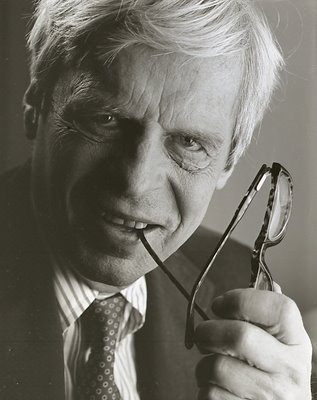
My friend John Lekich suggested that I keep on the drinking theme by writing about our mutual experience with George Plimpton at the Wedgewood Hotel on November 1990. I threw the suggestion back and told him, "You write it."
---------------------------------------------------------------
When Alex suggested that I reminisce about our professional encounter with the late George Plimpton back in the early nineties, I was delighted to oblige. Alex and I have collaborated on many articles over the years. But the founder of the famed Paris Review – a legendary editor, writer and raconteur who launched his distinguished career by interviewing Dorothy Parker – is the only subject who ever suggested that we indulge in a cocktail before noon.
True to his impeccable Ivy League breeding, Plimpton offered us first crack at the little bottles in the hotel mini-bar before indulging in his personal choice of a gin and tonic. I recall a distinct thrill at raising a glass in the company of a man who was one of the guests at Truman Capote’s famed Black and White Ball back in the sixties.
As the originator of “participatory journalism” – a form of reportage that saw the young and gangly Plimpton partake in everything from boxing with Archie Moore to playing goal for the Boston Bruins – Alex and I were startled to discover that his most terrifying professional experience was playing the triangle under the demanding baton of Leonard Bernstein. At the time, George was toying with the idea of managing a wrestler who limited his ringside banter exclusively to Shakespearean text. As an example, he mimed an overhead body slam and roared: “I am the grass! I cover all!” When I suggested that he was still spry enough to actually play the role of cultivated wrester, his eyes lit up with excitement. “Do you really think I could do it?” he asked.
For the rest of our time together, George reclined on the bed and related intimate stories of his friendships with everyone from Hemingway to A.J. Liebling. He had that rare quality of being perfectly elegant and perfectly relaxed at the same time. When Alex suggested a portrait that involved Plimpton toying with the stem of his eyeglasses, his response proved that he was both a seasoned journalist and a true gentleman. “Of course,” he said. “I’ll do anything you’d like.”
A few years ago, I bumped into the publicist who shepherded him around town that day. “He couldn’t believe that you knew so much about who he really was,” she recalled. “You made him so very happy.” I went home, fixed myself a gin and tonic and thought of George.
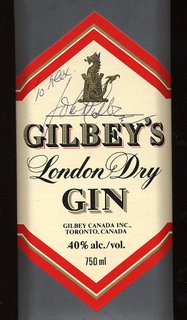
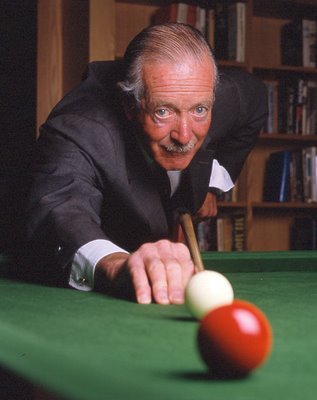
Sometime in early 1986 I arrived early to the billiard room of the Mandarin Hotel, the most luxurious hotel in Vancouver at the time. It is now the Metropolitan Hotel on Howe Street. I was there to take a portrait of:
The Honourable John Hugh Philip Gilbey, Lord Vaux of Harrowden. But he was also the unnoficial Ambassador of Gin.
I set up my light on one side of the billiard table and my large camera on the tripod. I was ready for the man. When he arrived he looked at me and said, "Alex you have everything ready, I see, but you did not take into consideration that I am a southpaw." I did not see myself putting my light stand on the billiard table to light Sir John from his left. I thought about it for a few seconds; I removed my Hudson's Bay Harris Tweed jacket, placed it on the table and then the light stand on it. I took ten exposures. Sir John gave me a bottle of gin which he autographed first. I have never opened it.
In his talk with writer Garry Marchant, Sir John told Marchant that his favourite gin drink was as a summer drink, a gin and tonic. He called it a long drink. But he said that his favourite drink of all was a fine claret or a bottle of vintage port "If I was in a condemned cell and they said I could have a jolly nice bottle of wine with my last meal, I'd choose a bottle of vintage port."
During the interview, in his room, I noticed a bottle of Tio Pepe on his private bar. I asked him why he had it. I found out that Sir John was related by marriage to the Spanish Gonzalez Byass company that makes the very pale and very dry sherry, my favourite soup improver ( a shot in consommé is divine). I asked him if he had concoted some sort of drink that included Gilbey's Gin and Tio Pepe. With a big smile in his face (after having sung the Gilbey's Gin Song while accompanying himself on the piano, he had a piano in his room) he said, "Yes, it's called Primos Hermanos (first cousins) and you substitute Tio Pepe for the vermouth in a martini.
I decided to try the drink in the downstairs bar. I ordered it and the bartender put a disgusting look on his face. Without going into details I told him, "I have it from the horse's mouth that this is a fine drink." Since I am not much of a connoisseur, all I can say is that it adequately suited my needs for that afternoon.
In 1995, the hotel was no longer the Mandarin Hotel and the library had lost the billiard table. I was present during a long interview with Evelyn Hart. Like most men I fell for the swan.

After the interview and my photos I asked Evelyn if she would accompany me for a drink dowstairs. She did. We had a couple of Primos Hermanos and I told her the story. She looked at me and said, "It's all right."
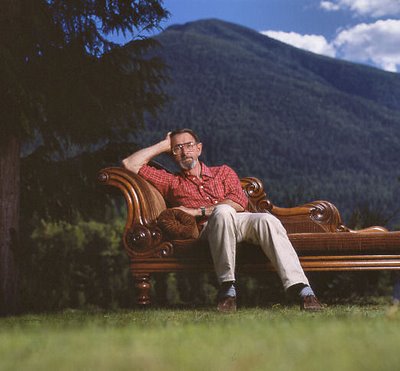

This blog and the next will pursue the theme of the previous one on drink.
In 1987 good magazines published fiction. Saturday Night published fiction. For their April issue they dispatched me to Nelson to photograph an author I did not know anything about. He was a mining engineer who had been born in a farm in Zululand, South Africa in 1918. His first language was Zulu. After her retired he began to write. He had come to be known in Canada because he had won the CBC Fiction Prize four times.
I arrived in my rented car from the airport, before noon and it almost became my undoing. The affable man told me I was going to stay for lunch and offered me a cocktail. During lunch we ate in a porch that overlooked Kootney Lake. The lake was right there and Havemann told me he liked to fish in his back yard. Lunch include several courses which were served with, "... this special white wine," and "...this superb red." Dessert came with port and and coffee was served with brandy and cigars. I was drunk. I photographed Havemann by his "pit privy". I loved how he pronounced it with a nasal twang. Then we carried the antique sofa outside and took his picture. He looked like a writer of the 19th century. When he suggested we have tea I was relieved. The tea would help me sober up. To my horror cold roast beef and egg sandwiches came with beer. There was no tea in sight.
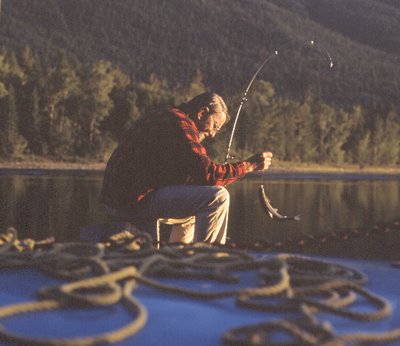
By the time I photographed Havemann pulling a fish from the lake (he had offered to do it with a confidence I had never seen in any other fishermen) I was having a problem setting up lights and moving around. I managed to finish. Havemann said, "Alex I think you should stay for dinner and fly out tomorrow." I thought of pre-dinner drinks, dinner drinks, dessert drinks and... so I politely declined and I somehow made it to the airport in one piece.
As soon as I got home I purchased Havemenann's Bloodsong - And Other Stories of South Africa. It is one of my favourite books of short stories. Oddly, when Saturday Night published one of the stories, Tom and Beauty, they edited out the first two paragraphs. Here they are:
We didn't have videos and peace movements in those days, so what we talked about where things like who made God, and should you tell your father if your mother was cheating on him.
Arabelle Jones's mother cheated when she went to dances, but Arabelle didn't tell her father: it would just make him more downtrodden. He was such a milktoast, he wouldn't do anything except perhaps desert her and her mother, and Arabelle would miss him. Mr Jones was rich.
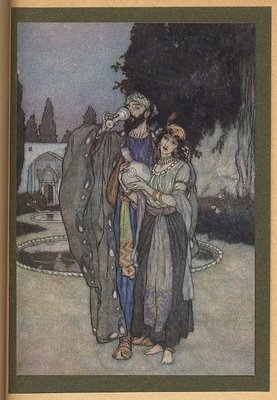
One of my mother's treasures was not a first edition of Omar Khayyám's Rubáiyát rendered into English by Edward Fitzgerald. She would have never been able to afford one. She had (and I inherited it) an early edition that incorporated Fitzgerald's first edition and his revised second edition. Noted illustrator Edmund Dulac did the fine illustrations which are pasted on to the this Hodder and Stoughton edition.
My father had a fondness for gin. There were countless nights where I heard him promise my mother that he was going to stop. There was a particular quatrain (as the verses in the Rubáiyát are called), quatrain LVII of the first edition, that hit a chord with my mother. Perhaps she read it out loud to my father. I don't know.
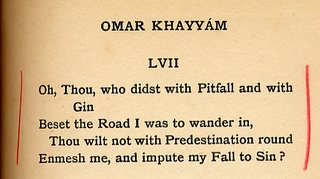
I do know that the page has two bold red pencil marks on either side.
My mother died in 1972 and in 1973 I discovered a Penguin edition of the Rubaiyyat (note that the accents are now gone) that was listed as: A new translation with critical comments by Robert Graves and Omar Ali-Shaw (a noted Sufi poet and classical Persian scholar).
It seems that my mother's beloved book had been a "transmogrification" (Fitzgerald's own word) of a 15th century Oxford manuscript. It was not not the earliest version of the famous Sufi work. An authorative 12-century version had been available to Sufic students in Afghanistan shortly after Khayaam's (note new spelling) death more that 830 years ago.
I was startled to read side by side comparisons and I was upset to find out that Fitzgerald had even used Arab/English dictionaries in a straight literary meaning of the word fashion for his work. The real meanings of the quatrains in Graves's translation, while not having the aura of romance, had in some cases a completely different meaning.
I wonder if this "true" edition might have pursuaded my father to quit his gin. My mother's marked quatrain LVII reads as follows in the Graves translation:
I shall possess myself of a great goblet
With pipes of wine for its replenishment,
Annulling former ties to Faith and Reason
By marriage with this daughter of the Vine.
Accurate or not my father might have replied from Fitzgerald's first edition, quatrain LXXI:
And much as Wine has play'd the Infidel,
And robb'd me of my Robe of Honour-
well,
I often wonder what the Vinters buy
One half so precious as the Goods they
sell.
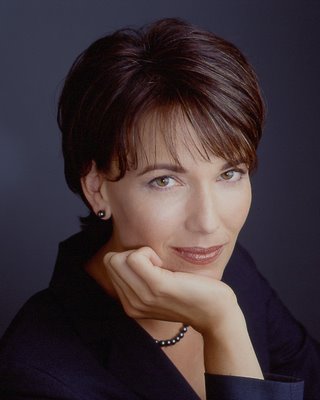
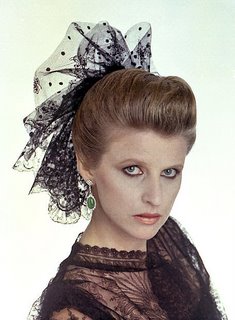
Be forewarned, if you read further, that I know little about television. My wife Rosemary and I limit ourselves to the Turner Classics Movies channel at 6:30 pm on Tuesdays for the Star of the Month series. This month we are thoroughly enjoying the films of Jean Arthur. While watching her it got me to thinking about CBC TV's Gloria Macarenko. There might not be any obvious connection unless you ever listened to Bill Richardson's fine CBC Radio program Bunny Watson, which like all good things had to go away. In that program Richardson showed how everything can be connected through association if you look hard enough. Jean Arthur was a forceful heroine who apparently in real life was absolutely terrified (unlike Katherine Hepburn as Bunny Watson) of appearing on a film set and fought nausea and worse. Yet she was so natural and wonderful.
There are forceful women in our media, particularly on CBC Radio, my radio station of choice. Mary Lou Finlay was one of my faves and Ana Maria Tramonti is growing on me. The most forceful of them all was Shelagh Rogers's ( Sounds Like Canada) mother who appeared on Rogers's show a few times. Her voice was stronger and her laugh louder than her daughter's. And of course there is the inimitable and wonderful Barbara Budd of As It Happens. Budd could make my granddaughter Lauren, 4, finish her Chicken a la Barbara (Lauren loathes it unless we call it paprika chicken) without any needed persuasion. On CBC radio, the women are women that are no-nonsense. They are intelligent. They matter to me. I would love to sit down for tea with any of them. I like them, I love them. But for TV, we Canadians ( at least here in Vancouver) choose a different kind of woman. She is not so forceful, she is more sensitive and there is some sort of Jean Arthur fragility and an almost hidden sadness that is masked by what seems to be an effortless performance. Two such women come to mind.
At 8:30 every weekday morning I get to hear Cecilia Walters (no speech impediment, no lisp, and a clean and crisp delivery) whom I met in the late 80s. She came to my studio for a photograph that accompanied a Vancouver Magazine profile. The magazine hired Sonny of Broadway to do her hair. I had my best makeup person and Tony Cavelti, escorted by an armed guard, brought the lovely emerald and diamonds ear rings you see in the picture here, above right. Perhaps we Canadians weren't as sophisticated then to appreciate a low key, sensitive (and intelligent) female TV news anchor and we would have settled for somewone like CNN's Paula Zahn. The little I have seen of Paula Zahn reminds me of that scene in Butterfield 8 where Elizabeth Taylor drills and then grinds her stiletto high heel on Lawrence Harvey's shoe. Paula Zahn would probably have made it even more painful for Harvey.
Since I prefer to read my news in my daily print edition of the New York Times at 6:30 am, I have seen little of Gloria Macarenko on TV. But I have seen enough to be charmed and drawn in. For news of Vancouver I listen to CBC radio. I have had the good fortune of having Macarenko in my studio a couple of times. I don't think any man in my place could feel any different than I felt when this woman looked into my lens and straight (it would seem) into my soul. Then she spoke to me in her perfect Castilian. Had I been a few years younger (this happened in 1999) I would have challenged her husband to a duel at 6am (with time to rush home to read the NY Times) in the back alley to Holy Rosary Cathedral. I subsequently met the charming Mr Enrique Manchon, who is a terrific photographer, socially at art openings and desisted from striking him with my glove.
Recently I asked Macarenko if I could bring my granddaughter Rebecca to watch her during her CBC News: Canada Now broadcast. We did (escorted and given a tour of the place by cameraman Michael Varga) and as I watched this woman, I realized why it is that I love Canada and I why I especially like to live in Vancouver. We are now sophisticated enough and un-American enough to appreciate what we could not, back then with Cecilia Walters. Macarenko is the perfect TV news anchor. I wonder if the CBC knows? Rebecca was charmed by Macarenko and the next day nobody in school would believe that she had actually seen her live and talked to her!
Macarenko has been doing her own makeup for years (oh! the scandal) because the CBC does not have the budget for a makeup person. I am sure that if Jennifer Mather, in her new CBC TV show, does not get her makeup, there will be holes in her producer's shoes.
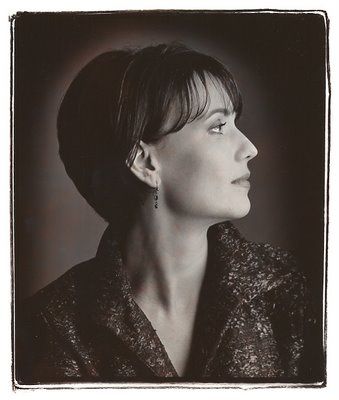

In May 1997, the University of Western Ontario announced the sale of three violins - a 1689 Baumgartner Stradivarius, a 1702 Lyall Stradivarius and a 1729 Guarneri del Gesù to an American purchaser. The buyer requested anonymity and then loaned all three instruments to the Canada Council Instrument Bank for a two year period. In 1997 Canadian volinist, Martin Beaver (31) was the winner of a competition, and as a prize he won the two-year loan of the Guarnerius.
I could post here sites comparing the Stradivarius (the Rolls Royce of violins) to the Guarnerius (the Bentley). The fact is that few may know that there were several Guarneri from Cremona who made violins, and that one, Bartolomeo Guiseppe Guarneri (1698-1744) is the most famous of the family. His violins always incorporated a label that had the Greek characters I.H.S. (iota - eta - sigma or iesu) and a Roman cross.
Guiseppe Guarneri has been known since as Guarneri del Gesù. It is only recently that the Guarneri violins have stopped being Bentleys.
Many experts and musicians, in spite of the fact that some of the Guarneri violins are bigger, almost fattish, and not too pretty, now believe that they are superior to the Stradivarius. I have heard Corey Cerovsek's Stradivarius in concert and he even brought it to my studio but I didn't dare ask him to play it. Beaver (left) did play his Guarnerius and he commented on the wonderful acoustics of my studio. I wish I had a musician's memory for this sort of thing so I could compare. And I have had a few opportunities to compare violins. Violinists Marc Destrubé and Paul Luchkow brought and played their instruments in my studio. Mark Fewer, concertmaster of the Vancouver Symphony Orchestra played his electric violin, and Karen Gerbrecht, and Cam Wilson, and Rebecca Whittling and Robin Braun, their violins and Laura Kramer her baroque cello, and Colin MacDonald his soprano saxophone, and Peggy Lee her modern cello, Glenys Webster played her viola, Patricia Hutter her string bass and.......my studio is on a third floor with no elevator. I believe I will never hear a piano. A harpsichord, perhaps?
Next time Corey Cerovsek comes to town I will invite him for tea to my studio and ask him to bring along his violin.
Addendum by Paul Luchkow
Hi Alex,
My friend Michael Jarvis has a square Chickering parlour piano that is easily moveable... You may get a piano yet. And, my current 'modern' violin is a true modern instrument--It was made by a couple of luthiers in NYC. It is, however, a copy of the "Alard" Guarneri del Gesu. (1742)
Paul
Addendum by CBC producer and broadcaster Michael Juk
Hi Alex,
I just had lunch with Mark Fewer and am at my desk editing a CD of music by Oskar Maorawetz performed by Jasper Wood so the violin theme seems to be very strong at the moment.
That del Gesu was a beauty. I remember being struck by how yellow the colour was. I think the finish had just been redone at that time. Martin told me the instrument required quite a bit of strength to play. Del Gesus tend to have a bigger voice than strads and are often used for concertos. Perlman has a Strad for chamber music and a del Gesu for concertos.
MJ
Martin Beaver
Corey Cerovsek
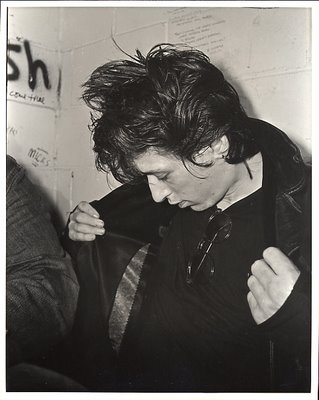
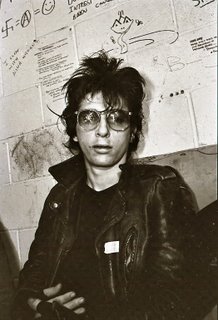
In 1981 I had the scary fortune of being able to be in the back room of Gary Taylor's Rock Room with Johnny Thunders ex guitarist (then) of the New York Dolls. His concerts began late and would sometimes finish early, when he would pass out on stage. I think that the people who went to see Thunders were divided into two groups. One group was there to see if the combination of Courvoisier and heroin would finally kill the man then and there. Others like my friend Les Wiseman and I were there to hear him play the guitar. In a 30 minute set there might be 5 or 10 minutes of passionate and virtuoso guitar that had no equal anywhere. Taking shots of Thunders put me in a spot as I had always tried to make people look as good as I could. He looked hopeless. While doing my shots, Thunders told me it was only fair that he take my picture. This he did.

A couple of years later Les Wiseman and I went to New York and we had the good fortune of seeing Thunders again. He was carried off stage when he passed out. We patiently waited almost an hour. He came back and gave us what so few musicians seem to be able to do now. He gave us music from the heart. As did our very own Art Bergmann, but that's another story.
Gary Taylor's
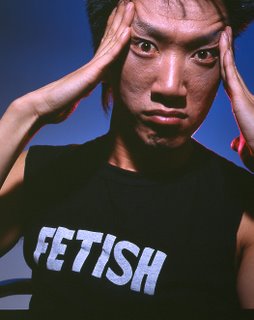
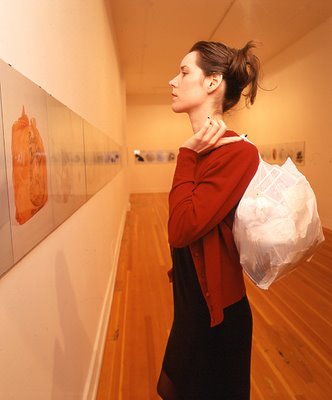
While there are many pleasures in taking photographs for publication, one of the decided downers is that those photographs appear and are then swallowed into oblivion. It is only if you have any self-confidence to realize you are any good that you can survive the silence that invariably follows. But there are some rare exceptions. Here are two.
I photographed then (1887) video artist Paul Wong for Vancouver Magazine. A year later, since I was an Outreach instructor at Emily Carr I was invited to participate in a faculty art show. One of the pictures I exhibited was a b+w version of this one of Paul Wong. When he posed for me he told me, "I really want to look Chinese."
In 1999 I photographed photographic artist Kelly Wood for a review of her show Continuous Garbage Project for the Globe & Mail. In the photo here she is holding the last bag (March 14, 1999) of her March 15, 1988 to March 14, 1999 project. When I arrived at the Catriona Jeffries Gallery on Granville Street, Wood smiled at me and told me she was honoured to have a real (that's the word she used)photographer photograph her.
As for Paul Wong, his photograph disappeared the day after the opening of the show at Emily Carr. I have my suspicions.
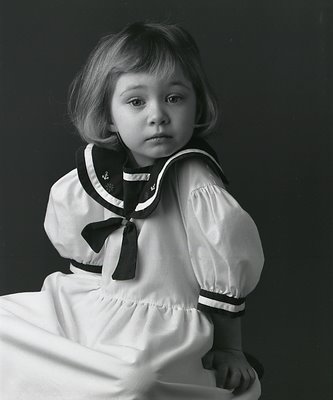
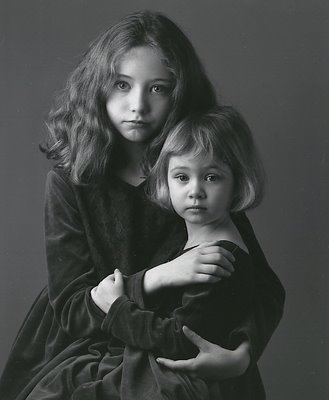
The true snapshot has disappeared from most photographers' grasp. When box cameras and 620 roll film ruled the world (the little Leica's were tiny "gadgets" that snapped at the heals of the lumbering box cameras) friends would tell you, "I hope they come out," or "Good luck." Snapshots were photographs that "turned out" when most of them didn't. We appreciated snapshots because we were lucky to get them, to have them. Can a digital camera take snapshots? Can an image that is captured (to parlay the modern lingo) be a snapshot when we can see it instantly and we can delete it and or re-take it?
I have wanted to photograph my grandaughters in the controlled lighting environment of my studio for almost a year. The problem was trying to find a friendly makeup artist to do the honours since my eldest daughter was playing vague and uncommitted. A couple of makeup artists I know either had a too busy schedule or were burned out. Finally my wife lured my Ale in a "if we do this for your you will do this for us" exchange. That was yesterday.
We had several dresses for Lauren (4) but besides Rebecca's former sailor dress and Lauren's wine coloured Christmas dress that was the end of it. She refused to cooperate. Rebecca at 9 was even more difficult. She stamped her feet, looked at my camera cross-eyed and threatened to cry which would have run all of Ale's expertly applied mascara.
Here are some of the results. The colour picture is a scanned Polaroid, of Rebecca in her Halloween costume. It is the closest I have ever gotten to "chimping".
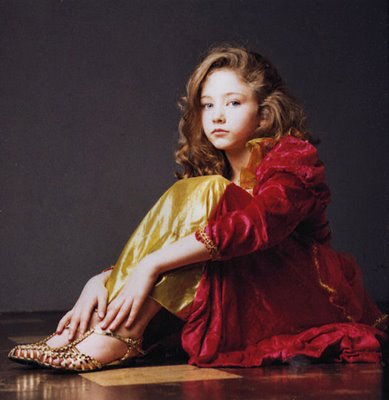
To chimp is to look at the LCD image in the back of digital camera and where you make that instant decision (or not) to scramble a real live person's photons into a region beyond William Gibson's cyberspace. Perhaps they go to that hallowed place were all the snapshots we ever took, that never turned out, still exist as latent images that could have been.
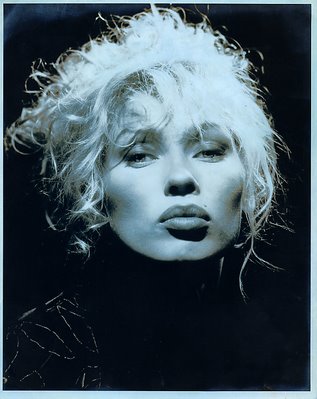
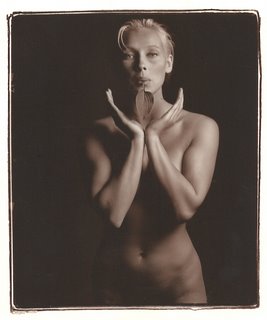
At one time I was going to write a book 1001 Photographic Mistakes & How To Avoid Them. I pursuaded myself that this was a bad idea as I kept inventing new mistakes every day. I would have endless revisions. With film on the wane there are now brand new methods of guaranteeing you will get home with no photographs to show for your efforts. Most of these mistakes involve electronic failures that can happen silently without you ever knowing. These failures (corrupt storage cards and files) are far more complex than the innocent one of opening a processing tank with the lights on. For years I have attempted to avoid failure by using consistent methods that never varied. My Mamiya RB will not function without film in its film backs. The motor drive of my Nikon F-3 has so much torque that there are various ways in which film will not advance (film will jump the sprockets or the gears will tear the sprocket holes) and I have taken 36 pictures in the same frame. After repeated failure with the F-3 I was always extra careful.
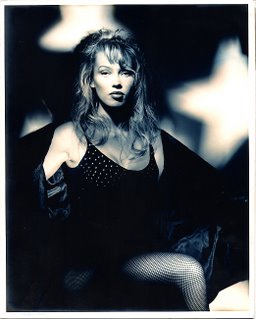
In spite of it all I have had my successes and none can beat my collaboration with Lisa Montonen in 1991. I photographed her twice. In my first efforts I concentrated on using Hollywood glamour lighting of the 40s. I toned the photographs with a chemical blue toner and varied the colour by using a very hot hair dryer.
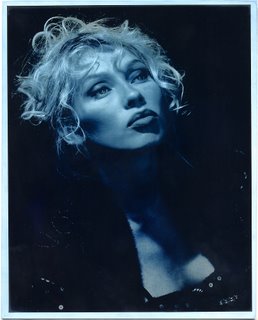
These tricks were the only tricks of an age before Photoshop. The second session involved taking pictures of Lisa with my hostas.
When I look at these photographs I have ambivalent thoughts. I know I can never take photographs like those anymore. Lisa now lives in Los Angeles and I don't plan in flying there. They were perfect photographs for me then when I approached (with an innocence of youth) my female subjects as remote but beautiful godesses. it was some time after taking pictures of Lisa that I came to realize that the goddesses, they were not and they were like I was.
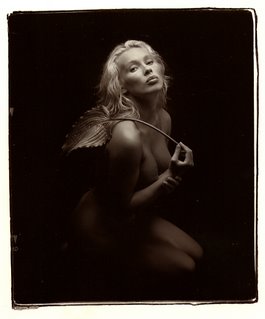
Now I avoid glamour and much of the clothing, if not all of it. I am interested in exploring what it is that attracts me to the undraped woman even after I explain to myself the attraction and the virtue of gardening, reading, eating, listening to Pandolfi or Corelli, and sharing time with my wife, granddaughters and cats. I can think of only one answer that begins to satisfy me, even though there are many more questions that are still unanswered.
From early prehistoric cave dwellers, to painters, sculptors and in the very beginning of photography the nude has always been an obsession with us all.
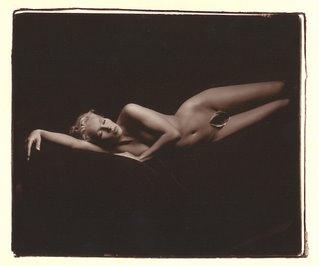
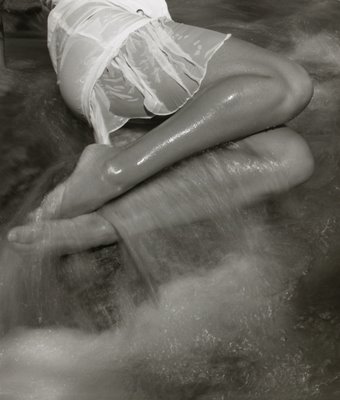
It is not usual for me to parade my failures here but here is one example. I modified how I approached my photographic subjects after this one. I sometimes wonder how I would react if I were on the other side of the camera. Lalita was and is a woman who looked like a young Sophia Loren. I took her to Lynn Canyon to excise from my system my inability to see the human foot as a lovely body part. Later in my studio Lalita explained with precise mathematics what areas and what percentages of her body I could record. I took my pictures while keeping my frustration inside. I swore I never would face such a situation again.
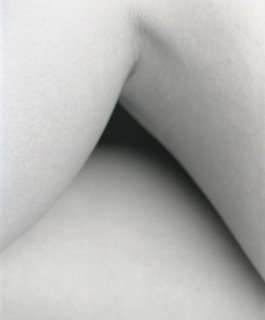
Before any subject of mine ever gets to my studio I state my intention in plain English, "If I were to ask you to undrape fully tell me now if there would be any objections." It has served me well.
But I do smile every time I remember what my friend Tony Ricci (who has a fondness for women) told me, "You mean all you did is photograph Lalita's feet? You must be crazy!"
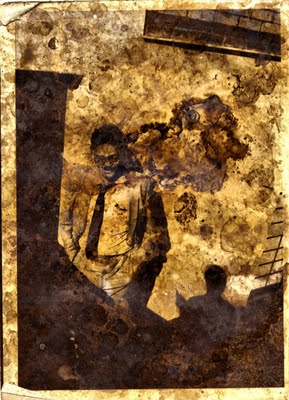
When I run into people I haven't seen for a while they ask me the same question. It is always a variation of, "Are you still....." As if photography is the kind of career you get on and off as you do a cable car. Nobody would have asked William Deverell that question back in 1979 when I photographed him outside Binky's Oyster Bar on Robson. Deverell a career criminal lawyer had just won the Seal First Novel for Needles. I am sure that when people run into Deverell now they never ask him if he is still writing. Perhaps there must be something unstable about being a photographer.
I don't think that's the case but photography is most definitely in a state of flux now and nobody can predict how it will all play. Yesterday I went into my darkroom and retrieved empty photo chemical jugs, colour negative processing tanks, colour analyzers for colour printing, a Polaroid instant slide processor, etc. Since Polaroid is all but bankrupt and they have not made instant slide film for years, the handsome processor must become landfill.
Much has been said about cameras (be they film or digital) being tools that apply to a problem at hand. The two camps, the digital and the film guys circling the wagons are still involved in heated arguments that parallel those between atheists and believers. They argue that one camera is the better tool over the other.
If I don't switch completely to digital it has to do with my inability to raise the funds to purchase a digital back (and all the needed peripherals) for my medium format cameras. I calculate I would need around $50,000. No piddly $6,000 digital Canon can match the detail I get with my film in medium format. Buying one of those would be tantamount to slumming.
But I have been thinking about this "a camera is a tool" thing and I have found my Eureka moment. A hammer and a screwdriver are both tools. With one in hand you will bang nails, remove them or tighten screws. In a pinch the screwdriver is good for making holes in the ground for planting seeds. I believe that tools inherently "suggest" to us what we can do with them. One problem with the high end DSLR (Digital Single Lens Reflex) camera is that the ads tell us all they can do untethered to a good light. I must say that for my kind of photography the lighting is all important.
Since I purchased my Epson 1640 SU flatbed scanner I have come to believe that my method of photography is a hybrid that incorporates the best of film and digital. But because I can think film (hammer) and/or digital (screwdriver) I find that I have many more choices and methods over the one or the other.
While cleaning out the empty bottles in my darkroom I spotted a dirty print that may have fallen many years ago (1979). It is that photograph of Deverell at Binky's. The negatives in my files (I processed them archivally) are in perfect condition and I could make a nice print in my wet darkroom. This version (accidental as it is) scanned with my Epson is a thing of beauty.
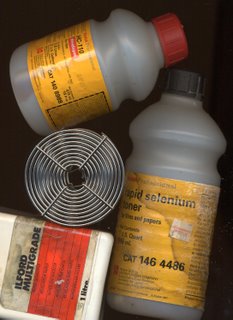
I still use the Ilford Multigrade developer of the picture and I tone them (for permanence) with Kodak selenium toner. I process most of my b+w film with Kodak HC-110, a syrup that resembles the maple kind and was a favourite (the HC-110) of Ansel Adams. The metal reel I use to process my negatives in the same way I did 45 years ago.
When horseless carriages started put-putting on the roads nobody was marketing units that would deposit ersatz horse droppings every few kms. Cars almost immediately made a clean break from the past in spite of running boards and coach lights. I think that the digital revolution in photography is in its infancy. It will have arrived when digital photographers stop trying to imitate what can be done with film.
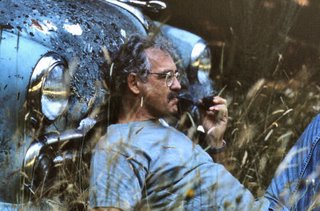 William Deverell
William Deverell
I hope that I am still around for that. And if people ask me if I am still....I will reply, "Yes I am still a photographer even though I may shoot with a digital camera some day," and to paraphrase St Augustine, "but God, not yet."

Football quarterbacks, after having a successful season, commonly give us highfalutin drivel about how they are nothing and it is all team work.
In photography, where Patterson's Law (it states that Murphy was an optimist) is in effect at all times and is guaranteed to ruin your photographic assignment, success can be measured in being able to return to the assigning photo editor with one useable image. A photographer without adequate support staff is no photographer. Since my father told me of King Arthur, Sword Excalibur and Merlin when I was a boy I have had an affinity with the legend. This affinity has made me find a parallel between Sword Excalibur and my Mamiya RB-67 Pro-S with its 140mm lens. When I am behind that combination I know I will not fail. This is, of course, if the camera itself is mechanically sound at the time. That's where Merlin comes in. I have my Merlin. He is camera repairman Horst Wenzel. In our 21st century philosophy of throwing away what does not work, Horst rejects it and upends it further by stating that in any camera he has opened nobody should be able to discern any traces of his entry and repair.
I marvel when I watch Horst work. He did not always deal with such tiny gears and levers. Horst was born in Zeven, Germany in 1939. In 1956 he was an apprentice shipbuilder. By 1959 when he moved to Canada he had help build many freighters and oiltankers including the 50,000 ton Esso Guilford at A.G. Weser in Bremen.
A few years ago Horst retired from his camera repair company, Vancam Service. He has always specialized in the good cameras: the Leicas, Rolleis, Hasselblads and the odd Alpa. He traveled many times to Europe for authorized training.
Horst is now retired and he is busier than ever in his basement shop that has some of the tiniest lathes I have ever seen. Going to Horst's with my beloved Mamiyas (and Nikons, and Pentaxes) is always an adventure into the wonders that I will find there. Horst has built exact scale models of WWII German battleships and cruisers including the Tirpitz, the Prinz Eugen, the Graf Spee and the Scharnhorst. Not only are they built in great detail some of them have working motors and are radio controlled. These are a delight every time I see them but the prize is a painting of his father Hans Wenzel, an officer in the German Army in 1943, that was painted by a friend, Fritz Schindler while both were at the Russian front.
While Horst was much too young to participate in the war I would think that he would have ambivalent feelings toward the winning allies and the Russians. The fact is that Horst loves American and British WWII movies. When he is not watching them on the TV that sits to one side of his camera work bench, he also enjoys sports programs that feature female Russian tennis players!
In the photo above Horst poses by his father's painting. Horst is holding an unfinished 3-D camera he is building. Yesterday, while getting ready to go to the airport to visit his mother in Zeven who is celebrating a plus 90 birthday, Horst told me, "I have very little time to finish things."
That's fine with me and I am sure all those other photographers, would agree, as long as he keeps our swords sharp.
And here is another picture of Horst. This is a b+w negative scanned on my flatbed with a sheet of white paper over it. I then reverse the image.
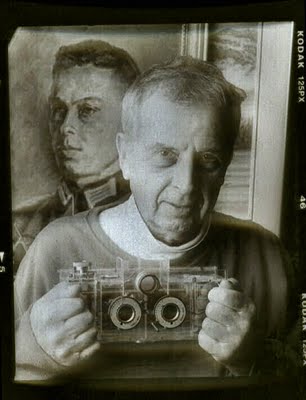
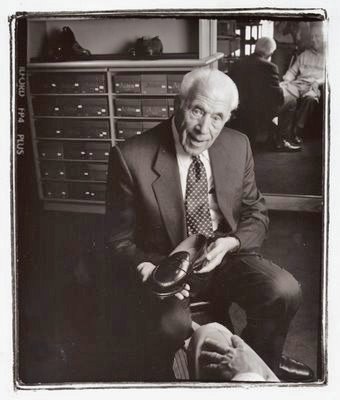
I have a friend, Graham Walker, who wears nice looking shoes that look either new or are polished to a sheen that makes me suspect spit is involved. I introduce him to my other friends as the man who has the shoe fetish. Graham smiles and never disagrees. I might know something about having a shoe fetish that I often keep to myself.
By the time I was 15 I was buying wine coloured, cordovan-leather Bostonian loafers at a store in Austin, Texas that sold Hart Schaffner & Marx suits. In 1965 I went into Lopez Taibo on Avenida Corrientes in Buenos Aires to buy a pair of their famous boots. The salesman eyed my sailor suit and rudely asked me if I was in the right store. I produced an American $100 bill (a lot of money in those days) and he immediately smiled and measured my feet. Close to 30 years later I returned to buy a new pair. The same man was working in a much reduced store on Corrientes. He did not remember me. I gave him my name and he came back with a box that had my measurements. I still have those Lopez Taibo boots today.
For a while I had expensive taste for good shoes and I shopped at Sheppard Shoes in the original location on West Hastings and when they moved further West. My salesman of choice was Gordon Slutsky. He sold me my last pair of Sheppard shoes in May 98 and a couple of years later the store closed.
Gordon Slutsky reminded me of Boris Karloff before he became famous making horror movies. Slutsky was quiet spoken and very gentle.
Gordon Slutsky started working with shoes in 1932 in Winnipeg. At the time Winnipeg had the same population as Vancouver and Canadians stood to sing "God Save the King". The brogues that Slutsky sold went for $8 a pair. Sixty six years later (in 1998) a lot of things had changed even though he still sold shoes. In this picture Slutsky is holding an Alden genuine shell cordovan loafer at $675 a pair. On some of the slow days Slutsky got to thinking about cows. He told me,
"I see a cow running in the meadow and I see milk. What other purpose does it fulfill? You can make a bunch of leather from it. You get this inanimate stuff, that's all leather is; you cut a pattern and voilà you have a pair of shoes."
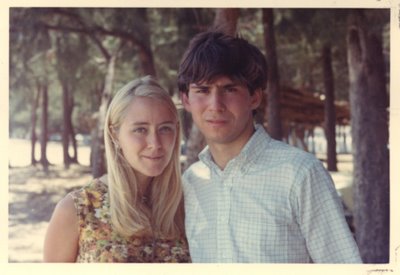
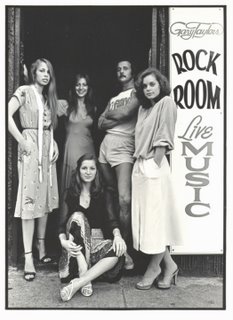
Few know that Houston is an ocean port. Ship channels from the Gulf of Mexico snake all their way to this Texan city. On December 31, 1966, on the stroke of midnight, I was having multiple toasts to my health and the health of all the officers sitting at the captain's table on board Río Aguapey, a ship of ELMA, Empresa Líneas Maritimas Argentinas (the then very active but now defunct Argentine Merchant Marine). We had our white wine with the salad, rosé with the white pasta, red with the entrecote, dry sherry with the soup (Argentines then served soup before the dessert)and moscato (a sweet red) with our flan. Brandy was served with the sopa inglesa (an Argentine version of trifle that has loads of brandy). When the cake came Argentine sparkling wines were opened. With our coffee we had Old Smuggler Scotch. I was returning from my two year stint in the Argentine Navy and the Aguapey was going to deposit me, hitting all the ports on the Gulf of Mexico, a few blocks from my home in Veracruz, Mexico. But my mother had decided to drive to Houston in her blue VW and surprise me. She had been wiring our ship that was anchored off the Houston Port and was getting no replies. How was she to know that the wireless officer was also sitting at our table and that we were all drunk?
I can count with one hand the times I have been drunk in my life. That New Year's in Houston was the first and probably the worst.
By 1989, Rosemary and I stopped having the desire to party at some hotel with a few people we knew and then hug all the people we didn't know at the stroke of midnight. Both of us miss the real New Years of our past together and in particular a couple we had in Veracruz, Mexico. In one of them we weren't married but I had oiled the hinges of my room well in my mother's house on Calle Navegantes. In both occasions the sirens of all the ships so near us in the port of Veracruz and all the others anchored on the gulf made those warm New Years difficult to top. If the nortes weren't blowing it was usually hot enough for us to drive to our favourite beach by the Mocambo Hotel. It was there were we had this picture taken in late December 1967.
One of the strangest New Years we ever had was around 1987 at Gary Taylor's Rock Room on Hornby Street. In the picture here you can see Gary Taylor with the not-yet-known body builder, Carla Temple, on the right. Rosemary and I were invited by Gary Taylor to a New Years celebration at his rock room. He liked to invite me because he knew I was a cheap guest who never drank any of his liquor or accepted any of the other high grade rewards he offered his best clientele. The entertainer that evening was Roy Forbes (then known simply as Bim). I was astonished that at midnight he took out a paper from his shirt pocket which had the lyrics of Auld Lang Syne which he obviously did not know. After finishing he sprayed Rosemary and I (we were, unluckily, in the front) with an entire bottle of Möet & Chandon. But the strangest part of the evening were three very young Polish sailors who kept smiling at me. I told Rosemary that I felt uncomfortable and that we should go home. As we were leaving the sailors caught us on our way out and told us in a a terrible broken English that I was the spitting image of Roman Polanski. They asked for my address. For years we received Christmas cards from them.
Veracruz
Veracruz mangoes

The last time I saw Howard Houston was in 1961. Both of us were wearing mortar boards as we were graduating from St Edward’s High School in Austin, Texas. I really had not known him very well for the first four years that I was a boarder at the Catholic school. Howard was day student. I was keenly jealous of his literary wit and his ability to write essays with almost no effort. I was jealous on how he could make the class laugh with his intelligent, intellectual and sophisticated humour. Meanwhile I had to fight back my own shyness and having no girlfriends because I did not know how to dance. I was a real geek. Knowing how to dance in sock hops was the only way we could meet girls. We could only go to town for a limited time on weekends. The girls from the Catholic school across the city, St Mary’s Academy, were bussed to our sock hops. They needed chaperoning as the only women we saw on campus was the one female cook who served us Korean War issue powdered eggs for breakfast.
Brother Edwin -St Ed's
Brother Edwin and the Easter Bunny
St. Ed's & Friendship
Brother Stanley and the circular slide rule
St Edward's High School Alumni Association Web Site
After our graduation Howard visited me at my home in Mexico City and we got to know each other better. He had been interested in my Pentacon single lens reflex back at St Ed's so he brought a much improved Miranda reflex camera. I was jealous! He took these pictures in Mexico from my apartment window facing Avenida Insurgentes Sur. Howard was fascinated with the mishmash of cars in Mexico City.

In particular he was delighted/horrified by the Plymouth Kingsway. This was a cheaped down Dodge that had a Dodge front end but the curvy fins of a Plymouth.

A few years back I found Howard through a web based St Edward’s reunion page. We have been happily communicating since. Howard lives in a very small community not too near Austin and his house is by a lake. I am happy to report that Howard’s wit has not changed in the least and that I am still jealous. For over a year he kept telling me how he had worked for the US Government. Only after some pressing on my side did he reveal that his government job was piloting a Boeing KC-135 tanker and that he and his crew re-fueled Phantom jets over Vietnam. I recently wrote to Howard for an explanation as to why he likes to live in isolation. Here is his delightful reply:
--------------------------------------------------------------------------------------------------------------------------------
In the movie Those Magnificent Men in Their Flying Machines, the opening scene happens at the start of a great international air race at an air park in England. The scene opens with Lord Whatsisname riding onto the field in his Rolls Royce with his male secretary. Lord Whatsisname says something like "You know Cyril; these international events would be quite all right if it were not for all the foreigners."
While I tend to agree with His Lordship on that, my real feeling is that "You know Alex, these public events like the opera, concerts, etc., would be quite all right if it were not for all the people."
I like people as individuals and in small groups. I literally cannot stand crowds. With an individual or a small group, you can sidle away from poor personal hygiene, ill mannered children, deadly boors, and people who want to convert you to their beliefs on whatever subject you care to name. However, in a crowd such people are, like pustules on the skin of a victim of smallpox, spread evenly throughout the mass thereby making it almost impossible to escape them. I, too, like the activities you mention, but would much prefer them after the local Legion Commander had ordered decimation; or several decimations. I think I was born to be an absolute monarch with private plays and concerts for a few select friends.
Other people like to press the flesh, so to speak, and big cities. I have no problem with that and, in fact, encourage it as those who like crowds will only find the crowds in the big cities and they have to go there to join the crowds thereby keeping the crowds where they belong, in the big city rather than out here with me.
We had 36 hours of continuous light sleet and freezing rain last week. It was the usual comedy of Texans trying to drive on ice as if it were no different than asphalt. The City of Austin was literally closed down for two full days. No mail delivery even.
Guest blogging! You have moved on into a fairly rarified atmosphere now. The internet and contraception for women. Vast and unpredictable changes are in the wind. Hillary is running for president. If she wins, those boys in the Middle East had better look out. Females protecting their children are considerably more dangerous than the male of the species. Also, she won't be too impressed with the colors available in hijabs.
Howard
Colin MacDonald & A Fast Italian Car On The Seattle Freeway
Monday, January 22, 2007


When London Calling came out in 1980 I remember driving back from Vancouver, Washington with my friend Les Wiseman. We passed through Seattle in the evening through the extra speedy inside freeway. As we sped in my Fiat X-19 the lights of the city flashed by in a blur as we listened to The Clash. I discovered then a new exciting genre of music that I call music-to-listen-to-while-driving- fast-through-a-city-at-night-or-on-a-long-bridge ( in a laid back Italian position, arms straight holding the steering wheel, with the seat as far back as possible).
For the music to be part of this genre it has to have an inexorable sense of purpose, an unfliching beat and, of course, it has to be heard extremely loud. I think Johann Sebastian Bach's Brandenburg Concerto No 2, in the super fast Pablo Casals version, would qualify as would (pure conjecture of mine) Joseph Haydn's Symphony No. 22, The Philosopher if it were performed on music overdrive. I cannot think of any 19th century music that fits the bill but in the 20th century, Maurice Ravel's Bolero would do me fine as would any composition by Philip Glass. In jazz, Paul Desmond's Take Five performed by the Dave Brubeck Quartet would shorten any trip. Perhaps its odd and disquieting (and obsessive) 5/4 time signature helps.
I thought of all the above as I had one heck of great time last night listening to composer/musician Colin MacDonald (above, left) and his Pocket Orchestra playing his music and that of three other contemporary composers. At least two, including Michael Nyman's Prospero's Magic had a bit of that Glass obsession and I was frustratingly trying not to "air" drive an exotic Italian car through Seattle at night. There were several reasons why the experience was pleasant. Besides Colin MacDonald on soprano saxophone, my friends, violinist Paul Luchkow (above, right) and cellist Laura Kramer (below, left) were part of the pocket orchestra.

I was accompanied by Graham Walker, my eldest daughter Ale (who brought snacks) and Paul's wife, violist Glenys Webster. Our new friend, visiting German Philipp Krieg, also raved about our evening.
MacDonald's Skillful Means was excellent bridge-crossing-material made all the better by an enthusiastic alto saxophonist, David Branter who, after my playing friends, was easily my favourite in the orchestra. Sitting next to MacDonald's soprano sax and with bass trombonist Brad Muirhead ( it looked like a normal trombone as the bell seemed small but it all had to do with the fact that Muirhead was one big man) behind, this was a solid brass and woodwind section that had a cool trumpet player in Geeta Das, who played in the later compositions. Her serious face contrasted sharply with Branter and the smiling Daniel Tones on percussion.
MacDonald's Reaching for Immortality , while having players performing in what this amateur reviewer would state was out of phase (Paul Luchkow told me it was fun to not have to play normal ensemble playing) had a very pleasant romantic streak.
But it was the last composition of the evening, Macdonald's The 5-Chambered Heart that was the high point of the evening for me. It had a 5/4 beat that was much too complex for me to figure out. It was a miracle that the orchestra could keep up with each other after I was told how little time they had to rehearse. The piece ended nice and slowly as my Maserati and I reached our destination.
It would not be fair for me not to mention that this Pocket Orchestra had Ya-Wen Vivienne Wang on the piano, Cori Somers on violin, Jared Burrows on bass guitar and Stefan Hintersteiniger on cello. The latter could take some smiling lessons from Laura Kramer who does it so well, besides playing a damn good cello.

For me the only bittersweet part of the evening was sensing the ghost of my departed lefty friend Ben Metcalf who will always haunt the small and intimate Western Front where this entertaining concert was held.
Holly Suicide - Daniela Ciccone
Sunday, January 21, 2007


In the late 70s and early 80s Holly Suicide, who looked like an overly made-up street urchin haunted the punk concerts of the Smiling Buddha on Hastings Street. She sometimes taunted the huge egg-shaped Igor the bouncer. As scary as I had first thought it all was, one could safely walk the streets then. My friend Les and I would walk to the Balmoral Hotel for its "cleaner" bathrooms and cheaper beer. I don't know what it was that Les might have said or done but he was actually ejected from the Balmoral one night.
When I drive North on West Georgia I sometimes look up to the old building on the north-east side, right on the corner with Bute.

It is astounding that this relatively attractive old building with trapezoidal bay windows has not come tumbling down to make way for The Newton west coast adult living condominium.
It was there that in the late 80s I photographed Holly Suicide's alter ego, Daniela Ciccone. I had that uncommon pleasure of looking out from the inside of those lovely bay windows.

Whistling Along - The B-Line Bus & The Auburn
Saturday, January 20, 2007


On any nice sunny day in the garden, especially on Sundays when the noise level of nearby Granville Street is down I have been listening to a strange whistling sound that has grown on me. The Kerrisdale tracks are seldom used by trains these days. I miss that midnight train siren. The only sound that evokes the romance of transport from the past is that curious relatively new whistle. My friend Paul Leisz who has been know to drive one, says it's the supercharger of the B-Line articulated bus engine.
In the mid 80s my daughter Ale and I had a thrilling ride in Ed Aveling's convertible Auburn. As we sped on the Upper Levels Highway I heard the whistling sound. I asked Aveling what the noise was. "It's the supercharger."
I photographed Aveling's Auburn and other antique cars for an article that Alyn Edwards had written for Vancouver Magazine. I got to see many fine cars but Aveling's Auburn was tops.

He lived in a house in West Van. In his living room he invited us to go down to the motor rooms to see his collection. It was then that I realized that he had designed (Aveling was a contractor) his house around separate garages (the motor rooms). He told me he had recently spent $7000 on new leather upholstery for the Auburn.
When Ale saw the car she asked, "Why is it that new cars in a showroom don't look as new as this one?"
Corrie Clark - Actress
Friday, January 19, 2007


I first met Corrie Clark ten years ago at an acting agency Christmas party. Malcolm Parry had invited me to accompany him on an evening's activities. Mac bantered with this diminutive young lady whose face could change so quickly that she reminded me of Jean Seberg, Rebecca de Mornay, a young Alice Liddell and in some moments Audrey Hepburn. I decided to be direct. Corrie Clark was receptive and I had three photo sessions with her in my studio.

I don't think that in all my years as a photographer in Vancouver have I ever had such a clash of wills with anybody as I did with Clark. She was difficult, rude, unreceptive (at times) but when I looked at my contacts of her I realized how amazing our "collaboration" was. So I suffered in silence.

I asked her if she could cry on demand for my camera. She did this easily. There was a touch of bitterness in the 26 or 27 year-old actress. It seems that she had been typecast as teenager in all the movies she made. She longed to be "made up in full" - to play a real adult.

But that was not to be at the time. She also played the young girl who is raped. She told me how she would be placed on a revolving bed after having to remove all her clothes in a crowded set and told to fake an orgasm when the film rolled. She made the poignant observation that dogs and other animals were treated better in some local productions.

I put these photos away and I forgot them. Recently I received a an email from Clark where she apologized for her actions in the past.

My only reaction is that I don't need an apology as these photographs are ample proof that I was rewarded in full.
Corrie Clark - Revisited

Al Tomko - Gentleman Wrestler
Thursday, January 18, 2007


The past can seem rosy in some cases precisely because it was. I have never held a job in Vancouver but the closest I ever got to a 9 to 5 job was in the height of the 80s when I was virtually taking most of the pictures at Vancouver Magazine. Mac Parry's magazine was on the corner of Davie and Richards and looking back I can assert that it was a centre of all things cultural, musical, theatrical and sometimes, even, it was a circus.
Vancouver Magazine then was a city magazine, our city magazine, during an era when city magazines mattered. Everybody knew this so those who were part of the city went over to Vancouver Magazine and asked to see the editor. More often than not they got their wishes. I remember a young man who walked in from the street with a collection of slides of people wearing Hawaii T shirts. A month later the magazine had a feature with just those pictures. On any given day (on one given day of a Christmas party Mac invited the local prostitutes in for drinks with us) you could bump into Max Wyman or in this case with legendary Winnipeg wrestler Al Tomko. Mac came up to me and told me, "Go home and fetch your lights. I want you to photograph this gentleman." A gentleman he was and my past on Davie and Richards was truly rosy.
Al Tomko
Toothpaste Glass 161
Wednesday, January 17, 2007

My maternal grandmother Lolita went to a boarding school for girls in Spain in the 19th century and was issued sterling silver cup No 161 to drink with her meals. I never asked her the name of the school or where in Spain her school was. I never asked her if all she drank out of it was water or how she polished it. By the mid 1950s the cup had been relegated to function as a toothpaste glass. We never ever called it a toothbrush glass. When I married Rosemary, she saw the sentimental value of cup 161 and insisted we display it with our collection of pocket watches and other family memorabilia.
For 39 years we have had a varied assortment of toothpaste glasses. In our early years in Burnaby, our daughters borrowed them for mixing watercolours and Rosemary and I might have popped Eno or Alka Seltzer to fight stomach ailments. I hated the plastic glasses and the glass ones either looked perpetually dirty or they would fall and break. I was much too lazy to vacuum the glass splinters. Once I bled over our white sheets with a cut foot. I learned my lesson. In the last year we have been practical. In a recent trip to Mexico we stayed overnight in a Seattle Travelodge and Rosemay pinched half a dozen plastic water cups which have been splendid. Or so I thought.
Rosemary's 15 year-old male cat, Toby, has always insisted in drinking his water from either the bathtub tap or the bathroom sink tap. Rosemary first tried leaving either taps running for a while. The water noise drove me nuts until I discovered that if I placed the Travelodge glass, full of water by the sink tap, Toby would climb up and happily drink from it.
Must I share my toothpaste glass with a cat? Or could it be the appropriate time to bring back my grandmother's school glass?
King Solomon's Mine, Thumbs Down - Navigator, Thumbs Up
Tuesday, January 16, 2007

There is a keen enjoyment in deciding on a movie that I can watch on a Saturday with Rebecca who is 9. I want to replicate those rosy periods of my life when my father and mother or my grandmother took me to the movies. It is difficult because going to the movies with them involved the excitement of taking the train to Retiro in Buenos Aires and then connecting from there on the "subte" (subway) that would take us to Lavalle which was the station below the long street that was one movie house after another. In what they called "programa continuado" we would go into a movie, and see the middle of the movie, the beginning and then we would leave where we had arrived to go to another. We saw cowboy, pirate movies and even war movies. If Abuelita did not like these movies she was pretty good at hiding it. After the shows we would then go and sip on tall strawberry or chocolate ice cream sodas. My parents were a bit more discerning and took me to see movies they wanted to see. That is how I saw Beau Geste and most of the other Gary Cooper films. My mother loved Herbert Marshall, Joseph Cotton, Ronald Colman, Stewart Granger (she took me to Scaramouche, twice) and Leslie Howard. We saw as many Gene Tierney movies as came to Argentina, including my favourite ghost story movie, The Ghost and Mrs. Muir with Rex Harrison. But I was scared to death by Katherine Hepburn's pants and hated her movies. My guess is that the woman confused my early sexuality. One of the best moments was going to see Laura (with not only Gene Tierney but with Dana Andrews) with my father and mother. I could not help but notice that my father's trench coat was very similar to Andrews's. That could be why I have had a special fondness for all of Dana Andrews's movies ever since.
Seeing a film on our own TV, without having to go anywhere, is not quite the same thing. It means that if the movie does not interest Rebecca she can get up and go to the piano or out into the garden. And she has been quick to do that. I have to be very selective.
I have picked some good ones which have backfired on me. Rebecca nags me that she wants to see Tarzan of the Apes again. We enjoyed Gunga Din but Roman Holiday taxed her attention span. I was right that the special effects of the much more recent (1985) Young Sherlock Holmes would suck her into seeing it. I would not be surprised if she insists we see Scaramouche again.
On Saturday night I took out two film DVDs from Videomatica. One I thought was a sure bet. I picked the Deborah Kerr and Stewart Granger Technicolor King Solomon's Mines. As soon as the the two hunters in a safari shot two elephants, Granger's sympathetic and sensitive safari leadership was not enough to calm down Rebecca. But on a lark I took out my favourite time-travel film of all time, Navigator: A Medieval Odyssey. This 1988 Vincent Ward New Zealand (in co-production with Australia) has a fairly complicated plot. Rebecca (and Lauren, 4, was never bored), was transfixed by the b+w portions of the film that give the impression someone took a time machine into a 14th century Cumbria copper-mining village to film it. Once it ended Rebecca ran to my computer to Google "the plague". I read her the best description on how the plague started from Edward Rutherford's Sarum.
1348
On a warm August morning, a little after dawn, the small ship had passed the low headland and come slowly through the sheltered harbour waters to tie up beside the quay at Christchurch. The ship contained a cargo of wine, from the English province of Gascony in south west France. The sailors, eight bluff, healthy fellows came briskly down the gangplank and were welcomed by the men of the waterfront. Soon afterwards they began to unload.
They did not know about their passenger and his small companion.
Rebecca was shocked when Rutherford reveals the mysterious passenger to be a black rat and his companion a common flea.
Film Essay
Cocktails With George, Alex & The Wrestler Who Never Was
Monday, January 15, 2007

My friend John Lekich suggested that I keep on the drinking theme by writing about our mutual experience with George Plimpton at the Wedgewood Hotel on November 1990. I threw the suggestion back and told him, "You write it."
---------------------------------------------------------------
When Alex suggested that I reminisce about our professional encounter with the late George Plimpton back in the early nineties, I was delighted to oblige. Alex and I have collaborated on many articles over the years. But the founder of the famed Paris Review – a legendary editor, writer and raconteur who launched his distinguished career by interviewing Dorothy Parker – is the only subject who ever suggested that we indulge in a cocktail before noon.
True to his impeccable Ivy League breeding, Plimpton offered us first crack at the little bottles in the hotel mini-bar before indulging in his personal choice of a gin and tonic. I recall a distinct thrill at raising a glass in the company of a man who was one of the guests at Truman Capote’s famed Black and White Ball back in the sixties.
As the originator of “participatory journalism” – a form of reportage that saw the young and gangly Plimpton partake in everything from boxing with Archie Moore to playing goal for the Boston Bruins – Alex and I were startled to discover that his most terrifying professional experience was playing the triangle under the demanding baton of Leonard Bernstein. At the time, George was toying with the idea of managing a wrestler who limited his ringside banter exclusively to Shakespearean text. As an example, he mimed an overhead body slam and roared: “I am the grass! I cover all!” When I suggested that he was still spry enough to actually play the role of cultivated wrester, his eyes lit up with excitement. “Do you really think I could do it?” he asked.
For the rest of our time together, George reclined on the bed and related intimate stories of his friendships with everyone from Hemingway to A.J. Liebling. He had that rare quality of being perfectly elegant and perfectly relaxed at the same time. When Alex suggested a portrait that involved Plimpton toying with the stem of his eyeglasses, his response proved that he was both a seasoned journalist and a true gentleman. “Of course,” he said. “I’ll do anything you’d like.”
A few years ago, I bumped into the publicist who shepherded him around town that day. “He couldn’t believe that you knew so much about who he really was,” she recalled. “You made him so very happy.” I went home, fixed myself a gin and tonic and thought of George.
Lord Gilbey Sips A Tio Pepe
Sunday, January 14, 2007


Sometime in early 1986 I arrived early to the billiard room of the Mandarin Hotel, the most luxurious hotel in Vancouver at the time. It is now the Metropolitan Hotel on Howe Street. I was there to take a portrait of:
The Honourable John Hugh Philip Gilbey, Lord Vaux of Harrowden. But he was also the unnoficial Ambassador of Gin.
I set up my light on one side of the billiard table and my large camera on the tripod. I was ready for the man. When he arrived he looked at me and said, "Alex you have everything ready, I see, but you did not take into consideration that I am a southpaw." I did not see myself putting my light stand on the billiard table to light Sir John from his left. I thought about it for a few seconds; I removed my Hudson's Bay Harris Tweed jacket, placed it on the table and then the light stand on it. I took ten exposures. Sir John gave me a bottle of gin which he autographed first. I have never opened it.
In his talk with writer Garry Marchant, Sir John told Marchant that his favourite gin drink was as a summer drink, a gin and tonic. He called it a long drink. But he said that his favourite drink of all was a fine claret or a bottle of vintage port "If I was in a condemned cell and they said I could have a jolly nice bottle of wine with my last meal, I'd choose a bottle of vintage port."
During the interview, in his room, I noticed a bottle of Tio Pepe on his private bar. I asked him why he had it. I found out that Sir John was related by marriage to the Spanish Gonzalez Byass company that makes the very pale and very dry sherry, my favourite soup improver ( a shot in consommé is divine). I asked him if he had concoted some sort of drink that included Gilbey's Gin and Tio Pepe. With a big smile in his face (after having sung the Gilbey's Gin Song while accompanying himself on the piano, he had a piano in his room) he said, "Yes, it's called Primos Hermanos (first cousins) and you substitute Tio Pepe for the vermouth in a martini.
I decided to try the drink in the downstairs bar. I ordered it and the bartender put a disgusting look on his face. Without going into details I told him, "I have it from the horse's mouth that this is a fine drink." Since I am not much of a connoisseur, all I can say is that it adequately suited my needs for that afternoon.
In 1995, the hotel was no longer the Mandarin Hotel and the library had lost the billiard table. I was present during a long interview with Evelyn Hart. Like most men I fell for the swan.

After the interview and my photos I asked Evelyn if she would accompany me for a drink dowstairs. She did. We had a couple of Primos Hermanos and I told her the story. She looked at me and said, "It's all right."
Having A Drink With Ernst Havemann
Saturday, January 13, 2007


This blog and the next will pursue the theme of the previous one on drink.
In 1987 good magazines published fiction. Saturday Night published fiction. For their April issue they dispatched me to Nelson to photograph an author I did not know anything about. He was a mining engineer who had been born in a farm in Zululand, South Africa in 1918. His first language was Zulu. After her retired he began to write. He had come to be known in Canada because he had won the CBC Fiction Prize four times.
I arrived in my rented car from the airport, before noon and it almost became my undoing. The affable man told me I was going to stay for lunch and offered me a cocktail. During lunch we ate in a porch that overlooked Kootney Lake. The lake was right there and Havemann told me he liked to fish in his back yard. Lunch include several courses which were served with, "... this special white wine," and "...this superb red." Dessert came with port and and coffee was served with brandy and cigars. I was drunk. I photographed Havemann by his "pit privy". I loved how he pronounced it with a nasal twang. Then we carried the antique sofa outside and took his picture. He looked like a writer of the 19th century. When he suggested we have tea I was relieved. The tea would help me sober up. To my horror cold roast beef and egg sandwiches came with beer. There was no tea in sight.

By the time I photographed Havemann pulling a fish from the lake (he had offered to do it with a confidence I had never seen in any other fishermen) I was having a problem setting up lights and moving around. I managed to finish. Havemann said, "Alex I think you should stay for dinner and fly out tomorrow." I thought of pre-dinner drinks, dinner drinks, dessert drinks and... so I politely declined and I somehow made it to the airport in one piece.
As soon as I got home I purchased Havemenann's Bloodsong - And Other Stories of South Africa. It is one of my favourite books of short stories. Oddly, when Saturday Night published one of the stories, Tom and Beauty, they edited out the first two paragraphs. Here they are:
We didn't have videos and peace movements in those days, so what we talked about where things like who made God, and should you tell your father if your mother was cheating on him.
Arabelle Jones's mother cheated when she went to dances, but Arabelle didn't tell her father: it would just make him more downtrodden. He was such a milktoast, he wouldn't do anything except perhaps desert her and her mother, and Arabelle would miss him. Mr Jones was rich.
The Rubáiyát & A Rubaiyyat - On Gin
Friday, January 12, 2007

One of my mother's treasures was not a first edition of Omar Khayyám's Rubáiyát rendered into English by Edward Fitzgerald. She would have never been able to afford one. She had (and I inherited it) an early edition that incorporated Fitzgerald's first edition and his revised second edition. Noted illustrator Edmund Dulac did the fine illustrations which are pasted on to the this Hodder and Stoughton edition.
My father had a fondness for gin. There were countless nights where I heard him promise my mother that he was going to stop. There was a particular quatrain (as the verses in the Rubáiyát are called), quatrain LVII of the first edition, that hit a chord with my mother. Perhaps she read it out loud to my father. I don't know.

I do know that the page has two bold red pencil marks on either side.
My mother died in 1972 and in 1973 I discovered a Penguin edition of the Rubaiyyat (note that the accents are now gone) that was listed as: A new translation with critical comments by Robert Graves and Omar Ali-Shaw (a noted Sufi poet and classical Persian scholar).
It seems that my mother's beloved book had been a "transmogrification" (Fitzgerald's own word) of a 15th century Oxford manuscript. It was not not the earliest version of the famous Sufi work. An authorative 12-century version had been available to Sufic students in Afghanistan shortly after Khayaam's (note new spelling) death more that 830 years ago.
I was startled to read side by side comparisons and I was upset to find out that Fitzgerald had even used Arab/English dictionaries in a straight literary meaning of the word fashion for his work. The real meanings of the quatrains in Graves's translation, while not having the aura of romance, had in some cases a completely different meaning.
I wonder if this "true" edition might have pursuaded my father to quit his gin. My mother's marked quatrain LVII reads as follows in the Graves translation:
I shall possess myself of a great goblet
With pipes of wine for its replenishment,
Annulling former ties to Faith and Reason
By marriage with this daughter of the Vine.
Accurate or not my father might have replied from Fitzgerald's first edition, quatrain LXXI:
And much as Wine has play'd the Infidel,
And robb'd me of my Robe of Honour-
well,
I often wonder what the Vinters buy
One half so precious as the Goods they
sell.
Gloria Macarenko & Cecilia Walters vs Shelagh Rogers's Mother
Thursday, January 11, 2007


Be forewarned, if you read further, that I know little about television. My wife Rosemary and I limit ourselves to the Turner Classics Movies channel at 6:30 pm on Tuesdays for the Star of the Month series. This month we are thoroughly enjoying the films of Jean Arthur. While watching her it got me to thinking about CBC TV's Gloria Macarenko. There might not be any obvious connection unless you ever listened to Bill Richardson's fine CBC Radio program Bunny Watson, which like all good things had to go away. In that program Richardson showed how everything can be connected through association if you look hard enough. Jean Arthur was a forceful heroine who apparently in real life was absolutely terrified (unlike Katherine Hepburn as Bunny Watson) of appearing on a film set and fought nausea and worse. Yet she was so natural and wonderful.
There are forceful women in our media, particularly on CBC Radio, my radio station of choice. Mary Lou Finlay was one of my faves and Ana Maria Tramonti is growing on me. The most forceful of them all was Shelagh Rogers's ( Sounds Like Canada) mother who appeared on Rogers's show a few times. Her voice was stronger and her laugh louder than her daughter's. And of course there is the inimitable and wonderful Barbara Budd of As It Happens. Budd could make my granddaughter Lauren, 4, finish her Chicken a la Barbara (Lauren loathes it unless we call it paprika chicken) without any needed persuasion. On CBC radio, the women are women that are no-nonsense. They are intelligent. They matter to me. I would love to sit down for tea with any of them. I like them, I love them. But for TV, we Canadians ( at least here in Vancouver) choose a different kind of woman. She is not so forceful, she is more sensitive and there is some sort of Jean Arthur fragility and an almost hidden sadness that is masked by what seems to be an effortless performance. Two such women come to mind.
At 8:30 every weekday morning I get to hear Cecilia Walters (no speech impediment, no lisp, and a clean and crisp delivery) whom I met in the late 80s. She came to my studio for a photograph that accompanied a Vancouver Magazine profile. The magazine hired Sonny of Broadway to do her hair. I had my best makeup person and Tony Cavelti, escorted by an armed guard, brought the lovely emerald and diamonds ear rings you see in the picture here, above right. Perhaps we Canadians weren't as sophisticated then to appreciate a low key, sensitive (and intelligent) female TV news anchor and we would have settled for somewone like CNN's Paula Zahn. The little I have seen of Paula Zahn reminds me of that scene in Butterfield 8 where Elizabeth Taylor drills and then grinds her stiletto high heel on Lawrence Harvey's shoe. Paula Zahn would probably have made it even more painful for Harvey.
Since I prefer to read my news in my daily print edition of the New York Times at 6:30 am, I have seen little of Gloria Macarenko on TV. But I have seen enough to be charmed and drawn in. For news of Vancouver I listen to CBC radio. I have had the good fortune of having Macarenko in my studio a couple of times. I don't think any man in my place could feel any different than I felt when this woman looked into my lens and straight (it would seem) into my soul. Then she spoke to me in her perfect Castilian. Had I been a few years younger (this happened in 1999) I would have challenged her husband to a duel at 6am (with time to rush home to read the NY Times) in the back alley to Holy Rosary Cathedral. I subsequently met the charming Mr Enrique Manchon, who is a terrific photographer, socially at art openings and desisted from striking him with my glove.
Recently I asked Macarenko if I could bring my granddaughter Rebecca to watch her during her CBC News: Canada Now broadcast. We did (escorted and given a tour of the place by cameraman Michael Varga) and as I watched this woman, I realized why it is that I love Canada and I why I especially like to live in Vancouver. We are now sophisticated enough and un-American enough to appreciate what we could not, back then with Cecilia Walters. Macarenko is the perfect TV news anchor. I wonder if the CBC knows? Rebecca was charmed by Macarenko and the next day nobody in school would believe that she had actually seen her live and talked to her!
Macarenko has been doing her own makeup for years (oh! the scandal) because the CBC does not have the budget for a makeup person. I am sure that if Jennifer Mather, in her new CBC TV show, does not get her makeup, there will be holes in her producer's shoes.
Gloria Macarenko

Martin Beaver's 1729 Guarneri del Gesù
Wednesday, January 10, 2007

In May 1997, the University of Western Ontario announced the sale of three violins - a 1689 Baumgartner Stradivarius, a 1702 Lyall Stradivarius and a 1729 Guarneri del Gesù to an American purchaser. The buyer requested anonymity and then loaned all three instruments to the Canada Council Instrument Bank for a two year period. In 1997 Canadian volinist, Martin Beaver (31) was the winner of a competition, and as a prize he won the two-year loan of the Guarnerius.
I could post here sites comparing the Stradivarius (the Rolls Royce of violins) to the Guarnerius (the Bentley). The fact is that few may know that there were several Guarneri from Cremona who made violins, and that one, Bartolomeo Guiseppe Guarneri (1698-1744) is the most famous of the family. His violins always incorporated a label that had the Greek characters I.H.S. (iota - eta - sigma or iesu) and a Roman cross.

Guiseppe Guarneri has been known since as Guarneri del Gesù. It is only recently that the Guarneri violins have stopped being Bentleys.
Many experts and musicians, in spite of the fact that some of the Guarneri violins are bigger, almost fattish, and not too pretty, now believe that they are superior to the Stradivarius. I have heard Corey Cerovsek's Stradivarius in concert and he even brought it to my studio but I didn't dare ask him to play it. Beaver (left) did play his Guarnerius and he commented on the wonderful acoustics of my studio. I wish I had a musician's memory for this sort of thing so I could compare. And I have had a few opportunities to compare violins. Violinists Marc Destrubé and Paul Luchkow brought and played their instruments in my studio. Mark Fewer, concertmaster of the Vancouver Symphony Orchestra played his electric violin, and Karen Gerbrecht, and Cam Wilson, and Rebecca Whittling and Robin Braun, their violins and Laura Kramer her baroque cello, and Colin MacDonald his soprano saxophone, and Peggy Lee her modern cello, Glenys Webster played her viola, Patricia Hutter her string bass and.......my studio is on a third floor with no elevator. I believe I will never hear a piano. A harpsichord, perhaps?
Next time Corey Cerovsek comes to town I will invite him for tea to my studio and ask him to bring along his violin.
Addendum by Paul Luchkow
Hi Alex,
My friend Michael Jarvis has a square Chickering parlour piano that is easily moveable... You may get a piano yet. And, my current 'modern' violin is a true modern instrument--It was made by a couple of luthiers in NYC. It is, however, a copy of the "Alard" Guarneri del Gesu. (1742)
Paul
Addendum by CBC producer and broadcaster Michael Juk
Hi Alex,
I just had lunch with Mark Fewer and am at my desk editing a CD of music by Oskar Maorawetz performed by Jasper Wood so the violin theme seems to be very strong at the moment.
That del Gesu was a beauty. I remember being struck by how yellow the colour was. I think the finish had just been redone at that time. Martin told me the instrument required quite a bit of strength to play. Del Gesus tend to have a bigger voice than strads and are often used for concertos. Perlman has a Strad for chamber music and a del Gesu for concertos.
MJ
Martin Beaver
Corey Cerovsek
Johnny Thunders From The Heart
Monday, January 08, 2007


In 1981 I had the scary fortune of being able to be in the back room of Gary Taylor's Rock Room with Johnny Thunders ex guitarist (then) of the New York Dolls. His concerts began late and would sometimes finish early, when he would pass out on stage. I think that the people who went to see Thunders were divided into two groups. One group was there to see if the combination of Courvoisier and heroin would finally kill the man then and there. Others like my friend Les Wiseman and I were there to hear him play the guitar. In a 30 minute set there might be 5 or 10 minutes of passionate and virtuoso guitar that had no equal anywhere. Taking shots of Thunders put me in a spot as I had always tried to make people look as good as I could. He looked hopeless. While doing my shots, Thunders told me it was only fair that he take my picture. This he did.

A couple of years later Les Wiseman and I went to New York and we had the good fortune of seeing Thunders again. He was carried off stage when he passed out. We patiently waited almost an hour. He came back and gave us what so few musicians seem to be able to do now. He gave us music from the heart. As did our very own Art Bergmann, but that's another story.
Gary Taylor's
Wood & Wong - Two Compliments - One Underhanded


While there are many pleasures in taking photographs for publication, one of the decided downers is that those photographs appear and are then swallowed into oblivion. It is only if you have any self-confidence to realize you are any good that you can survive the silence that invariably follows. But there are some rare exceptions. Here are two.
I photographed then (1887) video artist Paul Wong for Vancouver Magazine. A year later, since I was an Outreach instructor at Emily Carr I was invited to participate in a faculty art show. One of the pictures I exhibited was a b+w version of this one of Paul Wong. When he posed for me he told me, "I really want to look Chinese."
In 1999 I photographed photographic artist Kelly Wood for a review of her show Continuous Garbage Project for the Globe & Mail. In the photo here she is holding the last bag (March 14, 1999) of her March 15, 1988 to March 14, 1999 project. When I arrived at the Catriona Jeffries Gallery on Granville Street, Wood smiled at me and told me she was honoured to have a real (that's the word she used)photographer photograph her.
As for Paul Wong, his photograph disappeared the day after the opening of the show at Emily Carr. I have my suspicions.
Chimping Snapshots
Sunday, January 07, 2007


The true snapshot has disappeared from most photographers' grasp. When box cameras and 620 roll film ruled the world (the little Leica's were tiny "gadgets" that snapped at the heals of the lumbering box cameras) friends would tell you, "I hope they come out," or "Good luck." Snapshots were photographs that "turned out" when most of them didn't. We appreciated snapshots because we were lucky to get them, to have them. Can a digital camera take snapshots? Can an image that is captured (to parlay the modern lingo) be a snapshot when we can see it instantly and we can delete it and or re-take it?
I have wanted to photograph my grandaughters in the controlled lighting environment of my studio for almost a year. The problem was trying to find a friendly makeup artist to do the honours since my eldest daughter was playing vague and uncommitted. A couple of makeup artists I know either had a too busy schedule or were burned out. Finally my wife lured my Ale in a "if we do this for your you will do this for us" exchange. That was yesterday.
We had several dresses for Lauren (4) but besides Rebecca's former sailor dress and Lauren's wine coloured Christmas dress that was the end of it. She refused to cooperate. Rebecca at 9 was even more difficult. She stamped her feet, looked at my camera cross-eyed and threatened to cry which would have run all of Ale's expertly applied mascara.
Here are some of the results. The colour picture is a scanned Polaroid, of Rebecca in her Halloween costume. It is the closest I have ever gotten to "chimping".

To chimp is to look at the LCD image in the back of digital camera and where you make that instant decision (or not) to scramble a real live person's photons into a region beyond William Gibson's cyberspace. Perhaps they go to that hallowed place were all the snapshots we ever took, that never turned out, still exist as latent images that could have been.
Lisa Montonen & Ambivalent Thoughts
Saturday, January 06, 2007


At one time I was going to write a book 1001 Photographic Mistakes & How To Avoid Them. I pursuaded myself that this was a bad idea as I kept inventing new mistakes every day. I would have endless revisions. With film on the wane there are now brand new methods of guaranteeing you will get home with no photographs to show for your efforts. Most of these mistakes involve electronic failures that can happen silently without you ever knowing. These failures (corrupt storage cards and files) are far more complex than the innocent one of opening a processing tank with the lights on. For years I have attempted to avoid failure by using consistent methods that never varied. My Mamiya RB will not function without film in its film backs. The motor drive of my Nikon F-3 has so much torque that there are various ways in which film will not advance (film will jump the sprockets or the gears will tear the sprocket holes) and I have taken 36 pictures in the same frame. After repeated failure with the F-3 I was always extra careful.

In spite of it all I have had my successes and none can beat my collaboration with Lisa Montonen in 1991. I photographed her twice. In my first efforts I concentrated on using Hollywood glamour lighting of the 40s. I toned the photographs with a chemical blue toner and varied the colour by using a very hot hair dryer.

These tricks were the only tricks of an age before Photoshop. The second session involved taking pictures of Lisa with my hostas.
When I look at these photographs I have ambivalent thoughts. I know I can never take photographs like those anymore. Lisa now lives in Los Angeles and I don't plan in flying there. They were perfect photographs for me then when I approached (with an innocence of youth) my female subjects as remote but beautiful godesses. it was some time after taking pictures of Lisa that I came to realize that the goddesses, they were not and they were like I was.

Now I avoid glamour and much of the clothing, if not all of it. I am interested in exploring what it is that attracts me to the undraped woman even after I explain to myself the attraction and the virtue of gardening, reading, eating, listening to Pandolfi or Corelli, and sharing time with my wife, granddaughters and cats. I can think of only one answer that begins to satisfy me, even though there are many more questions that are still unanswered.
From early prehistoric cave dwellers, to painters, sculptors and in the very beginning of photography the nude has always been an obsession with us all.

A Failure In Body Parts
Friday, January 05, 2007

It is not usual for me to parade my failures here but here is one example. I modified how I approached my photographic subjects after this one. I sometimes wonder how I would react if I were on the other side of the camera. Lalita was and is a woman who looked like a young Sophia Loren. I took her to Lynn Canyon to excise from my system my inability to see the human foot as a lovely body part. Later in my studio Lalita explained with precise mathematics what areas and what percentages of her body I could record. I took my pictures while keeping my frustration inside. I swore I never would face such a situation again.

Before any subject of mine ever gets to my studio I state my intention in plain English, "If I were to ask you to undrape fully tell me now if there would be any objections." It has served me well.
But I do smile every time I remember what my friend Tony Ricci (who has a fondness for women) told me, "You mean all you did is photograph Lalita's feet? You must be crazy!"
William Deverell - Selenium Toner & My Eureka Moment
Thursday, January 04, 2007

When I run into people I haven't seen for a while they ask me the same question. It is always a variation of, "Are you still....." As if photography is the kind of career you get on and off as you do a cable car. Nobody would have asked William Deverell that question back in 1979 when I photographed him outside Binky's Oyster Bar on Robson. Deverell a career criminal lawyer had just won the Seal First Novel for Needles. I am sure that when people run into Deverell now they never ask him if he is still writing. Perhaps there must be something unstable about being a photographer.
I don't think that's the case but photography is most definitely in a state of flux now and nobody can predict how it will all play. Yesterday I went into my darkroom and retrieved empty photo chemical jugs, colour negative processing tanks, colour analyzers for colour printing, a Polaroid instant slide processor, etc. Since Polaroid is all but bankrupt and they have not made instant slide film for years, the handsome processor must become landfill.
Much has been said about cameras (be they film or digital) being tools that apply to a problem at hand. The two camps, the digital and the film guys circling the wagons are still involved in heated arguments that parallel those between atheists and believers. They argue that one camera is the better tool over the other.
If I don't switch completely to digital it has to do with my inability to raise the funds to purchase a digital back (and all the needed peripherals) for my medium format cameras. I calculate I would need around $50,000. No piddly $6,000 digital Canon can match the detail I get with my film in medium format. Buying one of those would be tantamount to slumming.
But I have been thinking about this "a camera is a tool" thing and I have found my Eureka moment. A hammer and a screwdriver are both tools. With one in hand you will bang nails, remove them or tighten screws. In a pinch the screwdriver is good for making holes in the ground for planting seeds. I believe that tools inherently "suggest" to us what we can do with them. One problem with the high end DSLR (Digital Single Lens Reflex) camera is that the ads tell us all they can do untethered to a good light. I must say that for my kind of photography the lighting is all important.
Since I purchased my Epson 1640 SU flatbed scanner I have come to believe that my method of photography is a hybrid that incorporates the best of film and digital. But because I can think film (hammer) and/or digital (screwdriver) I find that I have many more choices and methods over the one or the other.
While cleaning out the empty bottles in my darkroom I spotted a dirty print that may have fallen many years ago (1979). It is that photograph of Deverell at Binky's. The negatives in my files (I processed them archivally) are in perfect condition and I could make a nice print in my wet darkroom. This version (accidental as it is) scanned with my Epson is a thing of beauty.

I still use the Ilford Multigrade developer of the picture and I tone them (for permanence) with Kodak selenium toner. I process most of my b+w film with Kodak HC-110, a syrup that resembles the maple kind and was a favourite (the HC-110) of Ansel Adams. The metal reel I use to process my negatives in the same way I did 45 years ago.
When horseless carriages started put-putting on the roads nobody was marketing units that would deposit ersatz horse droppings every few kms. Cars almost immediately made a clean break from the past in spite of running boards and coach lights. I think that the digital revolution in photography is in its infancy. It will have arrived when digital photographers stop trying to imitate what can be done with film.
 William Deverell
William DeverellI hope that I am still around for that. And if people ask me if I am still....I will reply, "Yes I am still a photographer even though I may shoot with a digital camera some day," and to paraphrase St Augustine, "but God, not yet."
Horst Wenzel - Merlin & My Sword Excalibur
Wednesday, January 03, 2007

Football quarterbacks, after having a successful season, commonly give us highfalutin drivel about how they are nothing and it is all team work.
In photography, where Patterson's Law (it states that Murphy was an optimist) is in effect at all times and is guaranteed to ruin your photographic assignment, success can be measured in being able to return to the assigning photo editor with one useable image. A photographer without adequate support staff is no photographer. Since my father told me of King Arthur, Sword Excalibur and Merlin when I was a boy I have had an affinity with the legend. This affinity has made me find a parallel between Sword Excalibur and my Mamiya RB-67 Pro-S with its 140mm lens. When I am behind that combination I know I will not fail. This is, of course, if the camera itself is mechanically sound at the time. That's where Merlin comes in. I have my Merlin. He is camera repairman Horst Wenzel. In our 21st century philosophy of throwing away what does not work, Horst rejects it and upends it further by stating that in any camera he has opened nobody should be able to discern any traces of his entry and repair.
I marvel when I watch Horst work. He did not always deal with such tiny gears and levers. Horst was born in Zeven, Germany in 1939. In 1956 he was an apprentice shipbuilder. By 1959 when he moved to Canada he had help build many freighters and oiltankers including the 50,000 ton Esso Guilford at A.G. Weser in Bremen.
A few years ago Horst retired from his camera repair company, Vancam Service. He has always specialized in the good cameras: the Leicas, Rolleis, Hasselblads and the odd Alpa. He traveled many times to Europe for authorized training.
Horst is now retired and he is busier than ever in his basement shop that has some of the tiniest lathes I have ever seen. Going to Horst's with my beloved Mamiyas (and Nikons, and Pentaxes) is always an adventure into the wonders that I will find there. Horst has built exact scale models of WWII German battleships and cruisers including the Tirpitz, the Prinz Eugen, the Graf Spee and the Scharnhorst. Not only are they built in great detail some of them have working motors and are radio controlled. These are a delight every time I see them but the prize is a painting of his father Hans Wenzel, an officer in the German Army in 1943, that was painted by a friend, Fritz Schindler while both were at the Russian front.
While Horst was much too young to participate in the war I would think that he would have ambivalent feelings toward the winning allies and the Russians. The fact is that Horst loves American and British WWII movies. When he is not watching them on the TV that sits to one side of his camera work bench, he also enjoys sports programs that feature female Russian tennis players!
In the photo above Horst poses by his father's painting. Horst is holding an unfinished 3-D camera he is building. Yesterday, while getting ready to go to the airport to visit his mother in Zeven who is celebrating a plus 90 birthday, Horst told me, "I have very little time to finish things."
That's fine with me and I am sure all those other photographers, would agree, as long as he keeps our swords sharp.
And here is another picture of Horst. This is a b+w negative scanned on my flatbed with a sheet of white paper over it. I then reverse the image.

Gordon Slutsky - Shoe Salesman
Tuesday, January 02, 2007

I have a friend, Graham Walker, who wears nice looking shoes that look either new or are polished to a sheen that makes me suspect spit is involved. I introduce him to my other friends as the man who has the shoe fetish. Graham smiles and never disagrees. I might know something about having a shoe fetish that I often keep to myself.
By the time I was 15 I was buying wine coloured, cordovan-leather Bostonian loafers at a store in Austin, Texas that sold Hart Schaffner & Marx suits. In 1965 I went into Lopez Taibo on Avenida Corrientes in Buenos Aires to buy a pair of their famous boots. The salesman eyed my sailor suit and rudely asked me if I was in the right store. I produced an American $100 bill (a lot of money in those days) and he immediately smiled and measured my feet. Close to 30 years later I returned to buy a new pair. The same man was working in a much reduced store on Corrientes. He did not remember me. I gave him my name and he came back with a box that had my measurements. I still have those Lopez Taibo boots today.
For a while I had expensive taste for good shoes and I shopped at Sheppard Shoes in the original location on West Hastings and when they moved further West. My salesman of choice was Gordon Slutsky. He sold me my last pair of Sheppard shoes in May 98 and a couple of years later the store closed.
Gordon Slutsky reminded me of Boris Karloff before he became famous making horror movies. Slutsky was quiet spoken and very gentle.
Gordon Slutsky started working with shoes in 1932 in Winnipeg. At the time Winnipeg had the same population as Vancouver and Canadians stood to sing "God Save the King". The brogues that Slutsky sold went for $8 a pair. Sixty six years later (in 1998) a lot of things had changed even though he still sold shoes. In this picture Slutsky is holding an Alden genuine shell cordovan loafer at $675 a pair. On some of the slow days Slutsky got to thinking about cows. He told me,
"I see a cow running in the meadow and I see milk. What other purpose does it fulfill? You can make a bunch of leather from it. You get this inanimate stuff, that's all leather is; you cut a pattern and voilà you have a pair of shoes."
A Houston New Years, Mocambo & Gary Taylor's
Monday, January 01, 2007


Few know that Houston is an ocean port. Ship channels from the Gulf of Mexico snake all their way to this Texan city. On December 31, 1966, on the stroke of midnight, I was having multiple toasts to my health and the health of all the officers sitting at the captain's table on board Río Aguapey, a ship of ELMA, Empresa Líneas Maritimas Argentinas (the then very active but now defunct Argentine Merchant Marine). We had our white wine with the salad, rosé with the white pasta, red with the entrecote, dry sherry with the soup (Argentines then served soup before the dessert)and moscato (a sweet red) with our flan. Brandy was served with the sopa inglesa (an Argentine version of trifle that has loads of brandy). When the cake came Argentine sparkling wines were opened. With our coffee we had Old Smuggler Scotch. I was returning from my two year stint in the Argentine Navy and the Aguapey was going to deposit me, hitting all the ports on the Gulf of Mexico, a few blocks from my home in Veracruz, Mexico. But my mother had decided to drive to Houston in her blue VW and surprise me. She had been wiring our ship that was anchored off the Houston Port and was getting no replies. How was she to know that the wireless officer was also sitting at our table and that we were all drunk?
I can count with one hand the times I have been drunk in my life. That New Year's in Houston was the first and probably the worst.
By 1989, Rosemary and I stopped having the desire to party at some hotel with a few people we knew and then hug all the people we didn't know at the stroke of midnight. Both of us miss the real New Years of our past together and in particular a couple we had in Veracruz, Mexico. In one of them we weren't married but I had oiled the hinges of my room well in my mother's house on Calle Navegantes. In both occasions the sirens of all the ships so near us in the port of Veracruz and all the others anchored on the gulf made those warm New Years difficult to top. If the nortes weren't blowing it was usually hot enough for us to drive to our favourite beach by the Mocambo Hotel. It was there were we had this picture taken in late December 1967.
One of the strangest New Years we ever had was around 1987 at Gary Taylor's Rock Room on Hornby Street. In the picture here you can see Gary Taylor with the not-yet-known body builder, Carla Temple, on the right. Rosemary and I were invited by Gary Taylor to a New Years celebration at his rock room. He liked to invite me because he knew I was a cheap guest who never drank any of his liquor or accepted any of the other high grade rewards he offered his best clientele. The entertainer that evening was Roy Forbes (then known simply as Bim). I was astonished that at midnight he took out a paper from his shirt pocket which had the lyrics of Auld Lang Syne which he obviously did not know. After finishing he sprayed Rosemary and I (we were, unluckily, in the front) with an entire bottle of Möet & Chandon. But the strangest part of the evening were three very young Polish sailors who kept smiling at me. I told Rosemary that I felt uncomfortable and that we should go home. As we were leaving the sailors caught us on our way out and told us in a a terrible broken English that I was the spitting image of Roman Polanski. They asked for my address. For years we received Christmas cards from them.
Veracruz
Veracruz mangoes






